Table of Contents
- FUJITSU LIFEBOOK U7311
- Contents
- Innovative technology
- Ports and controls
- Important notes
- First-time setup of your device
- Working with the notebook
- Status indicators
- Switching on the notebook
- Notebook: switching off
- Keyboard
- Touchpad and touchpad buttons
- Touchscreen/LCD screen without touch function (device-dependent)
- WebCam and Infrared Camera
- ePrivacy Filter (optional)
- Rechargeable battery
- Using the power-management features
- Memory cards
- Loudspeakers and microphones
- SIM card (configuration dependent)
- Wireless components Wireless€LAN / Bluetooth / LTE
- Ethernet and LAN
- Your Port Replicator
- Security functions
- Connecting external devices
- Removing and installing components during servicing
- Settings in BIOS Setup Utility
- Starting the BIOS Setup Utility
- Operating the BIOS Setup Utility
- Exiting BIOS Setup Utility
- Exit Saving Changes - save changes and exit BIOS Setup Utility
- Exit Discarding Changes – Discard changes and exit BIOS Setup Utility
- Load Setup Defaults – Copy Standard Entries
- Discard Changes – Discard changes without exiting the BIOS Setup Utility
- Save Changes - save changes without exiting the BIOS Setup Utility
- Save Changes and Power Off
- Erase Disk
- Troubleshooting and tips
- Help if problems occur
- Restore contents of the hard disk from Recovery CD/DVD
- Restoring the system under Windows€10
- The notebook's date or time is incorrect
- When certain characters are entered on the keyboard, only numerals are written
- The notebook’s LCD screen remains blank
- The LCD screen is difficult to read
- The external monitor remains blank
- The external monitor is blank or the image is unstable
- The notebook cannot be started
- The notebook stops working
- The printer does not print
- The wireless connection to a network does not work
- SmartCard reader is not recognised.
- SmartCard PIN forgotten
- SmartCard lost
- Error messages on the screen
- Technical data
- Manufacturer’s notes
- Index
Fujitsu U7311 User Manual
Displayed below is the user manual for U7311 by Fujitsu which is a product in the Notebooks category. This manual has pages.
Related Manuals

System
Operating Manual
FUJITSU LIFEBOOK U7311

Congratulations on your purchase of an innovative
product from Fujitsu.
The latest information about our products, tips, updates etc. can be found
on the Internet at: "http://www.fujitsu.com/fts/"
You can find driver updates at: "http://support.ts.fujitsu.com/download"
Should you have any technical questions, please contact:
• our Hotline/Service Desk ("http://support.ts.fujitsu.com/contact/servicedesk")
• Your sales partner
• Your sales office
We hope you enjoy working with your new Fujitsu system!


FUJITSU LIFEBOOK U7311
Operating Manual
Innovative technology 7
Ports and controls 9
Important notes 12
First-time setup of your device 16
Working with the notebook 19
Security functions 48
Connecting external devices 55
Removing and installing components
during servicing 62
Settings in BIOS Setup Utility 63
Troubleshooting and tips 68
Technical data 77
Manufacturer’s notes 79
Index 80

Remarks
Information on the product description meets the design specifications of Fujitsu and
is provided for comparison purposes. Several factors may cause the actual results to
differ. Technical data is subject to change without prior notification. Fujitsu rejects any
responsibility with regard to technical or editorial mistakes or omissions.
Trademarks
Fujitsu, the Fujitsu logo and LIFEBOOK are registered trademarks of Fujitsu Limited
or its subsidiaries in the USA and other countries.
Microsoft and Windows are trademarks or registered trademarks of Microsoft
Corporation in the USA and/or other countries.
TM
The terms HDMI and HDMI High-Definition Multimedia Interface and the HDMI logo are trademarks or
registered trademarks of HDMI Licensing Administrator, Inc. in the United States and other countries.
Adobe Reader is a trademark of Adobe Systems Incorporated.
USB Type-C™ and USB-C™ are trademarks of the USB Implementers Forum
in the USA and other countries.
All other trademarks specified here are the property of their respective owners.
Copyright
No part of this publication may be copied, reproduced or translated without
the prior written consent of Fujitsu.
No part of this publication may be saved or transferred by any electronic means
without the written approval of Fujitsu.

Contents
Contents
Innovativetechnology ................................................................. 7
Further information ...................................................................... 7
Notational conventions .................................................................. 8
Portsandcontrols ..................................................................... 9
FUJITSU LIFEBOOKU7311 ............................................................. 9
Importantnotes ........................................................................ 12
Safetynotes ............................................................................ 12
Additional safety notes for devices with wireless components . . ............................. 13
Energysaving .......................................................................... 13
Energy saving under Windows ....................................................... 13
Travelling with yournotebook ............................................................ 14
Before you travel ................................................................... 14
Notebook:transporting ............................................................... 14
Cleaning thenotebook .................................................................. 15
First-time setup ofyourdevice ......................................................... 16
Unpacking and checking thedevice ...................................................... 16
Selectingalocat
ion ..................................................................... 17
Mains adapter connecting . . . . ........................................................... 17
Switchingonthedevice for the first time .................................................. 18
Workingwiththenotebook ............................................................ 19
Statusindicators ........................................................................ 19
Switching on the notebook . . . . ........................................................... 21
Notebook: switching off .................................................................. 21
Keyboard ............................................................................... 22
Virtualnumerickeypad .............................................................. 24
Functionkeys and keycombinations .................................................. 25
F-Lock setting ....................................................................... 27
Keyboard with background lighting (optional) . . ........................................ 27
Country and keyboard settings ....................................................... 27
Touchpadandtouchpadbuttons .......................................................... 28
Moving the pointer .................................................................. 28
Selectinganitem .................................................................... 28
Executing commands . . . . . ........................................................... 28
Draggingitems ...................................................................... 29
Touchscreen/LCD screen without touch function (device-dependent) . . . ..................... 29
Using fingers ....................................................................... 30
WebCam and Infrared Camera ........................................................... 31
ePrivacy Filter (optional) ................................................................. 31
Rechargeablebattery ................................................................... 32
Charging,caringforand maintaining the battery ....................................... 32
Removing andinstallingthebattery ................................................... 33
Usingthepower-managementfeatures ................................................... 35
Adjustingfan control ................................................................. 36
Memorycards .......................................................................... 37
Supported formats .................................................................. 37
Insertingthe memorycard ........................................................... 37
Removing thememory card .......................................................... 37
Loudspeakers and microphones . . . ....................................................... 38
Fujitsu 3

Contents
SIM card (configuration dependent) . . . . . . ................................................. 39
InsertingtheSIM card ............................................................... 39
Removing theSIMcard .............................................................. 40
Wireless components Wireless LAN / Bluetooth / LTE . . . . .................................. 41
Switching the wireless components on and off ......................................... 41
Settingup WLAN access ............................................................ 42
Accessvia LTE ..................................................................... 42
EthernetandLAN ....................................................................... 43
Your PortReplicator ..................................................................... 44
PortsonthePort Replicator .......................................................... 44
Connecting the notebook to the Port Replicator . . . . . .................................. 45
Connecting the mains adapter to the Port Replicator . .................................. 46
Switching on the notebook via the port replicator . . . . . .................................. 46
Disconnecting the notebook from the Port Replicator .................................. 47
Securityfunctions ..................................................................... 48
Configuring the fingerprint sensor ........................................................ 48
Configuringthe palm veinsensor ......................................................... 49
UsingtheSecurity Lock ................................................................. 49
Configuringpassword protectioninBIOS SetupUtility ...................................... 50
Protecting BIOS Setup Utility (supervisor and user password) . .......................... 50
Password protection for booting of the operating system . .............................. 52
Password protection for the harddisk ................................................. 52
Trusted Platform Module (TPM) (device-dependent) . . . . . .................................. 53
EnablingTPM ....................................................................... 53
DisablingTPM ...................................................................... 53
SmartCard reader ....................................................................... 54
InsertingtheSmartCard ............................................................. 54
Connectingexternaldevices ........................................................... 55
Connecting an external monitor . . ........................................................ 56
Connecting USB devices ................................................................ 58
USB port Intel® ThunderboltTM 4withchargingfunctionanddisplayport(USBType-C) .... 59
USB portwithcharging function(AnytimeUSBcharge) ................................. 60
How toremoveUSBdevicescorrectly ................................................ 60
Headset port ........................................................................... 61
Removing and installing components during servicing . . . .............................. 62
Settings in BIOS Setup Utility . . ........................................................ 63
StartingtheBIOS SetupUtility ........................................................... 63
OperatingtheBIOS SetupUtility ......................................................... 64
ExitingBIOSSetup Utility ................................................................ 65
Exit Saving Changes - save changes and exit BIOS Setup Utility . . . . ................... 65
Exit Discarding Changes – Discard changes and exit BIOS Setup Utility . . ............... 65
Load Setup Defaults – Copy Standard Entries ......................................... 65
Discard Changes – Discard changes without exiting the BIOS Setup Utility ............... 65
Save Changes - save changes without exiting the BIOS Setup Utility . ................... 65
Save Changes and Power Off . . . . . . ................................................. 65
EraseDisk ............................................................................. 66
Troubleshootingandtips .............................................................. 68
Helpifproblemsoccur ................................................................... 68
Restore contentsoftheharddiskfromRecoveryCD/DVD .................................. 69
4Fujitsu

Contents
Restoring the system under Windows 10 . . . . . . ............................................ 69
The notebook’s date or time is incorrect ................................................... 70
When certain characters are entered on the keyboard,only numerals are written ............. 70
The notebook’s LCD screen remains blank . . . . ............................................ 70
The LCD screen is difficulttoread ........................................................ 70
The externalmonitorremainsblank ...................................................... 71
The externalmonitorisblank or the imageisunstable ..................................... 71
The notebook cannot be started . . . ....................................................... 72
The notebook stops working . . ........................................................... 72
The printer does not print . . . . . ........................................................... 73
The wireless connection to a network does not work . . . .................................... 73
SmartCard reader is not recognised. . . . ................................................... 73
SmartCardPINforgotten ................................................................ 73
SmartCardlost ......................................................................... 74
Errormessagesonthescreen ........................................................... 75
Technicaldata ......................................................................... 77
LIFEBOOK ............................................................................. 77
Rechargeablebattery ................................................................... 77
Mains adapter (notebook computer) . . . ................................................... 78
Mains adapter (port replicator) ........................................................... 78
Manufacturer’snotes .................................................................. 79
Disposal andrecycling .................................................................. 79
TCO Certified ........................................................................... 79
Other certificationmarkings .............................................................. 79
Index .................................................................................. 80
Fujitsu 5

Contents
6Fujitsu

Innovative technology
Innovative technology
... and ergonomic design make your device a reliable and convenient companion.
The device boots very quickly, is ready for immediate use and offers a particularly
long operating time because of its high capacity battery.
With the user-friendly "BIOS Setup Utility" you can control your notebook’s hardware and better
protect your system against unauthorised access by using the powerful password properties.
Information on the connections and user components of your notebook
canbefoundin"Ports and controls", Page 9.
Further information
The Windows drivers for your device can be found on our Internet site.
The factory installation of your device does not support any other operating
system. Fujitsu Technology Solutions accepts no liability whatsoever
if any other operating system is used.
Software oriented components of these instructions refer to Microsoft products,
if they come within the scope of the delivery.
If you install other software products, pay attention to the operating
instructions of the manufacturer.
Fujitsu 7

Innovative technology
Notational conventions
Pay particular attention to text marked with this symbol. Failure to observe
these warnings could pose a risk to health, damage the device or lead
to loss of data. The warranty will be invalidated if the device becomes
defective through failure to observe these warnings.
Indicates important information for the proper use of the device.
►Indicates an activity that must be performed
Indicates a result
This font indicates data entered using the keyboard in a program dialogue or at
the command line, e.g. your password (Name123) or a command used to
start a program (start.exe)
This font indicates information that is displayed on the screen by a program, e.g.:
Installation is complete.
This font Indicates
• terms and texts used in a software interface, e.g.: Click on Save
• names of programs or files, e.g. Windows or setup.exe.
"This font" Indicates
• cross-references to another section, e.g. "Safety information"
• cross-references to an external source, e.g. a web address: For more
information, go to "http://www.fujitsu.com/fts/"
• Names of CDs, DVDs and titles or designations for other materials,
e.g.: "CD/DVD Drivers & Utilities" or "Safety/Regulations" manual
Key indicates a key on the keyboard, e.g: F10
This font indicates terms and texts that are emphasised or highlighted, e.g.: Do
not switch off the device
8Fujitsu

Ports and controls
Ports and controls
This chapter presents the individual hardware components of your device. It gives
an overview of the indicators and ports of the device. Please familiarise yourself with
these components before you start to work with the device.
FUJITSU LIFEBOOK U7311
Front
7
7
8
9
6
12
13
10
11
2
4
1
3
1
5
1 = Microphone (optional)
2 = WebCam-Shutter (optional)
3 = WebCam (optional)
4 = Infrared camera sensors (optional)
5 = WebCam LED (optional)
6 = Touchpad
7 = Loudspeakers
8 = Status indicators
9 = ON/OFF button
10 = Fingerprint sensor (optional) or palm
sensor (optional)
11 = Memory card slot
12 = Touchpad buttons
13 = Status indicators
Fujitsu 9
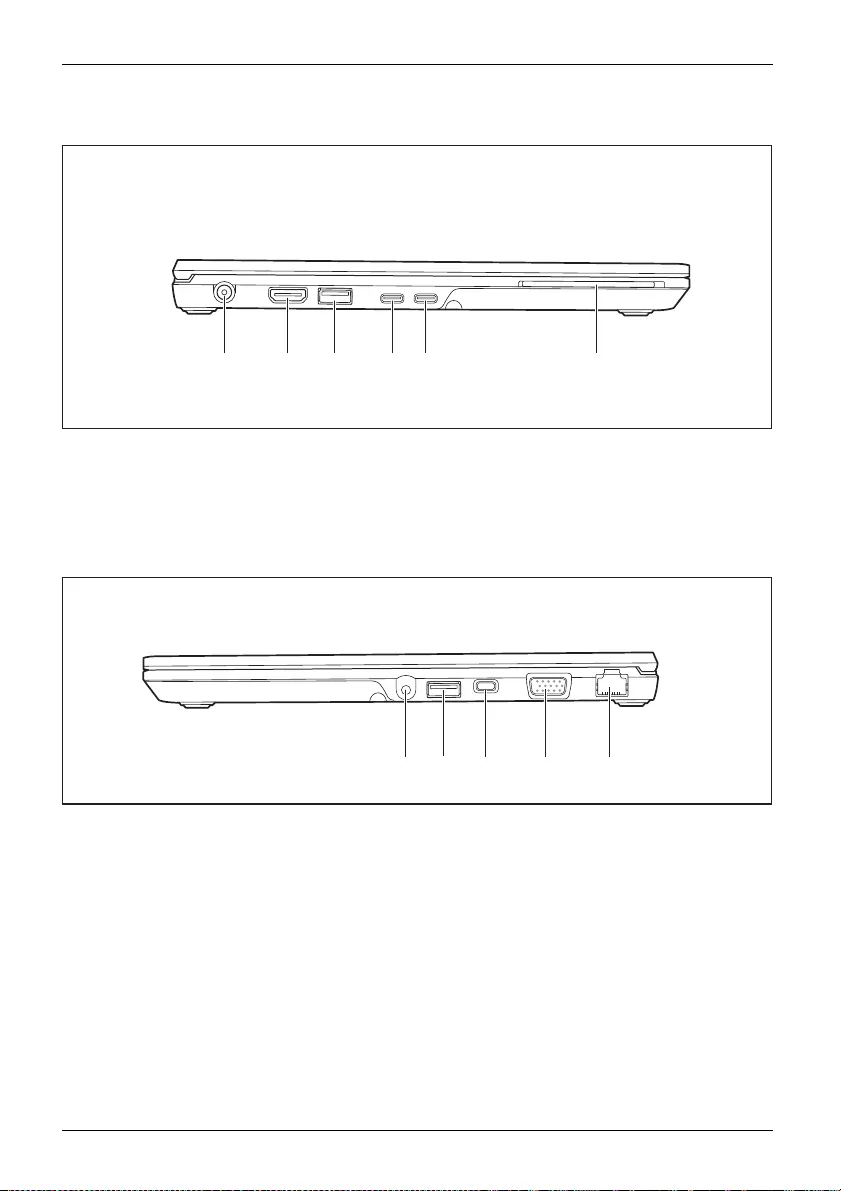
Ports and controls
Left side
1 2 3 4 54
1 = DC input connector (DC IN)
2 = HDMI port
3 = USB 3.2 Gen1 port with charging function
(USB Type-A, Anytime USB charge)
4 = USB port Intel® ThunderboltTM 4
with charging function and display
port (USB Type-C)
5 = SmartCard reader (optional)
Right side
2 3 45
1
1 = Headset jack
2 = USB port 3.2 Gen1 (USB Type-A)
3 = Security Lock device
4 = Monitor port (VGA)
5 = LAN port
10 Fujitsu

Ports and controls
Bottom
1
3
2
4
5
1 = Battery (SIM card under the battery)
2 = Battery release 1
3 = M.2 module and memory service
compartment
4 = Port replicator port
5 = Battery release 2
Fujitsu 11

Important notes
Important notes
ImportantnotesNotes
This chapter contains essential safety information which must be followed
when working with your notebook. Other notes also provide useful information
which will help you with your notebook.
Safety notes
SafetynotesNotes
Please follow the safety notes provided in the "Safety/Regulations" manual
as well as the safety notes given below.
Please pay special attention to the sections in the manual marked
with the symbol on the left.
When connecting and disconnecting cables, observe the relevant
notes in this operating manual.
In order to prevent burn injury or the device from overheating, do not lay the device
directly on your lap and make sure that the ventilation openings are not obstructed.
Read the information on the ambient conditions in the "Technical data",
Page 77 and "First-time setup of your device", Page 16 before preparing your
notebook for use and switching it on for the first time.
When cleaning the device, please observe the relevant notes in the
section "Cleaning the notebook", Page 15.
Pay attention to the additional safety notes for devices with wireless components
provided in the "Safety/Regulations" manual.
Please refer to the notes in the chapter "Removing and installing
components during servicing", Page 62.
This notebook complies with the relevant safety regulations for data processing
equipment. If you have questions about using your notebook in a particular area,
please contact your sales outlet or our Hotline/Service Desk.
Opening angle of the LCD screen
Please open the LCD screen carefully until you feel resistance. Do not try to open it further with force!
12 Fujitsu

Important notes
Additional safety notes for devices with
wireless components
Wirelesscom ponent :WirelessLAN:Bluetooth,safetynotes
If a wireless component (Wireless LAN, Bluetooth, UMTS, LTE) is incorporated into your notebook,
you must be sure to observe the following safety notes when using your notebook:
• Switch off the wireless components when you are in an aircraft or driving in a car.
• Switch off the wireless components when you are in a hospital, an operating
room or near a medical electronics system. The transmitted radio waves
can impair the operation of medical devices.
• Switch off the wireless components when you let the device get near flammable
gases or into hazardous environments (e.g. petrol station, paintshops), as the
transmitted radio waves can cause an explosion or a fire.
For information on how to switch wireless components on and off, see chapter
"Switching the wireless components on and off", Page 41.
Energy saving
NotesEnergyEnergysaving
Switch the notebook off when it is not in use. Switch off external, connected devices if you
are not using them. If you use the energy saving functions, the notebook uses less energy.
Youwillthenbeable to work for longer before having to recharge the battery.
Energy efficiency is increased and the environmental impact is reduced.
You save money while protecting the environment.
Energy saving under Windows
►Make use of the power management features (see ""Using the power-management features",
Page 35").
Fujitsu 13

Important notes
Travelling with your notebook
MobileoperationNotesTrans portati onNotebook
Please observe the points listed below when travelling with your notebook.
Before you travel
►Back up important data stored on your hard disk.
NotebookTravel,notebook
►Switch off the wireless component for data security reasons. With data traffic via a wireless
connection, it is also possible for unauthorised third parties to receive data.
Information on activating data encryption is provided in the documentation
for your wireless component.
►If you wish to use your notebook during a flight, first check with the flight
attendants if it is OK to do so.
When travelling in other countries
►If you are travelling abroad, check that the mains adapter can be operated with the
local mains voltage. If this is not the case, obtain the appropriate mains adapter for
your notebook. Do not use any other voltage converter!
►Check whether the local mains voltage and the power cable are compatible. If this is
not the case, buy a power cable that matches the local conditions.
►Contact the relevant authorities of the country you will be travelling in as to
whether you may operate the radio component integrated into your notebook
computer. Please observe the additional safety instructions for devices with radio
components, found in the handbook “Safety/formalities”.
Notebook: transporting
Protect the notebook from severe shocks and extreme temperatures
(e.g. direct sunlight in a car).
►Switch the notebook off.
►Unplug the mains adapter and all external devices from the power socket.
►Disconnect the mains adapter cable and the data cables for all external devices.
►Close the LCD screen.
►To protect against damaging jolts and bumps, use a notebook carrying
case to transport your notebook.
14 Fujitsu

Important notes
Cleaning the notebook
Do not clean any interior parts yourself; leave this job to a service technician.
Only use cleaning products designed for computers. Normal household
cleaners and polishes can damage the markings on the keyboard and the
device, the paintwork or the notebook itself.
Ensure that no liquid enters the notebook.
The LCD screen very sensitive to scratches. Only clean the display
surface with a very soft, slightly damp cloth.
►Switch the notebook off.
CleaningNotesNotebo okKeyboardTouchpadLCDscreen
►In order to prevent accidentially switching the device on, remove the power cable from the mains
adaptor and remove the battery (see "Removing and installing the battery", Page 33).
The surface can be cleaned with a dry cloth. If particularly dirty, use a cloth which has
been moistened in mild domestic detergent and then carefully wrung out.
You can use disinfectant wipes to clean the keyboard and the touchpad.
Ensure that no liquid enters the device.
Fujitsu 15

First-time setup of your device
First-time setup of your device
First- timese tupGettingstarted
Please read the chapter "Important notes", Page 12.
If your device is equipped with a Windows operating system, the necessary
hardware drivers and supplied software are already pre-installed.
Before you switch on the device for the first time, connect it to the mains voltage
using the mains adapter, see "Mains adapter connecting", Page 17.Themains
adapter must be connected during the entire installation process.
A system test is performed when your device is first switched on. Various messages
can appear. The display may remain dark for a short time or may flicker.
Please follow the instructions on the screen.
NEVER switch off your device during the first-time setup process.
When the device is delivered, the battery is located in the battery compartment. The battery
must be charged if you want to operate your device using the battery.
When used on the move, the built-in battery provides the device with the necessary power. You
can increase the operating time by using the available energy-saving functions.
For instructions on how to connect external devices (e.g. mouse, printer) to your
device, please refer to the operating manual for your device.
Unpacking and checking the device
Should you discover any damage that occurred during transportation,
notify your local sales outlet immediately!
►Unpack all the individual parts.
PackagingTransport
►Check your device for any visible damage which may have occurred during transportation.
You may need the packaging in the future, if you need to transport your device.
16 Fujitsu

First-time setup of your device
Selecting a location
SelectingalocationDeviceMainsadapt er
Select a suitable location for the device before setting it up. Follow
the instructions below when doing so:
• Never place the device or the mains adapter on a heat-sensitive surface.
The surface could be damaged as a result.
• Never place the device on a soft surface (e.g. carpeting, upholstered furniture,
bed). This can block the air vents and cause overheating and damage.
• The underside of the device heats up during normal operation. Prolonged contact
with the skin may become unpleasant or even result in burns.
• Place the device on a stable, flat, non-slippery surface. Please note that the
rubber feet of the device may mark certain types of delicate surfaces.
• Keep other objects at least 100 mm / 3.94 inches away from the device
and its mains adapter to ensure adequate ventilation.
• Never cover the ventilation slots of the device.
• Do not expose the device to extreme environmental conditions. Protect
the device from dust, humidity, and heat.
Mains adapter connecting
Preparingforo perationMainsadapter
Observe the safety notes in the enclosed "Safety/Regulations" manual.
The supplied power cable conforms to the requirements of the country in
which you purchased your device. Make sure that the power cable is approved
for use in the country in which you intend to use it.
3
1
2
►Connect the power cable (1) to the power
adapter provided for the device, see
chapter "Technical data", Page 77.
►Plug the mains cable (2) into a mains outlet.
►Connect the mains adapter cable (3) to
the DC jack (DC IN) of the device.
Fujitsu 17

First-time setup of your device
Switching on the device for the first time
Switchingonforthefirstt ime
When you switch on the device for the first time, the supplied software is
installed and configured. Because this procedure must not be interrupted,
you should set aside enough time for it to be fully completed and connect
the device to the mains using the mains adapter.
During the installation process, DO NOT restart the device unless
you are requested to do so!
To make it easier to use your device for the first time, the operating system
is pre-installed on the hard disk.
►Switch on your device.
►During installation, follow the instructions on screen.
If a Windows operating system is installed on your device, you will find more
information on the system and drivers, help programmes, updates, manuals etc. on
the device or on the Internet under "http://www.fujitsu.com/fts/support/".
You can find information and help on the Windows operating system functions
on the Internet at "http://windows.microsoft.com".
18 Fujitsu
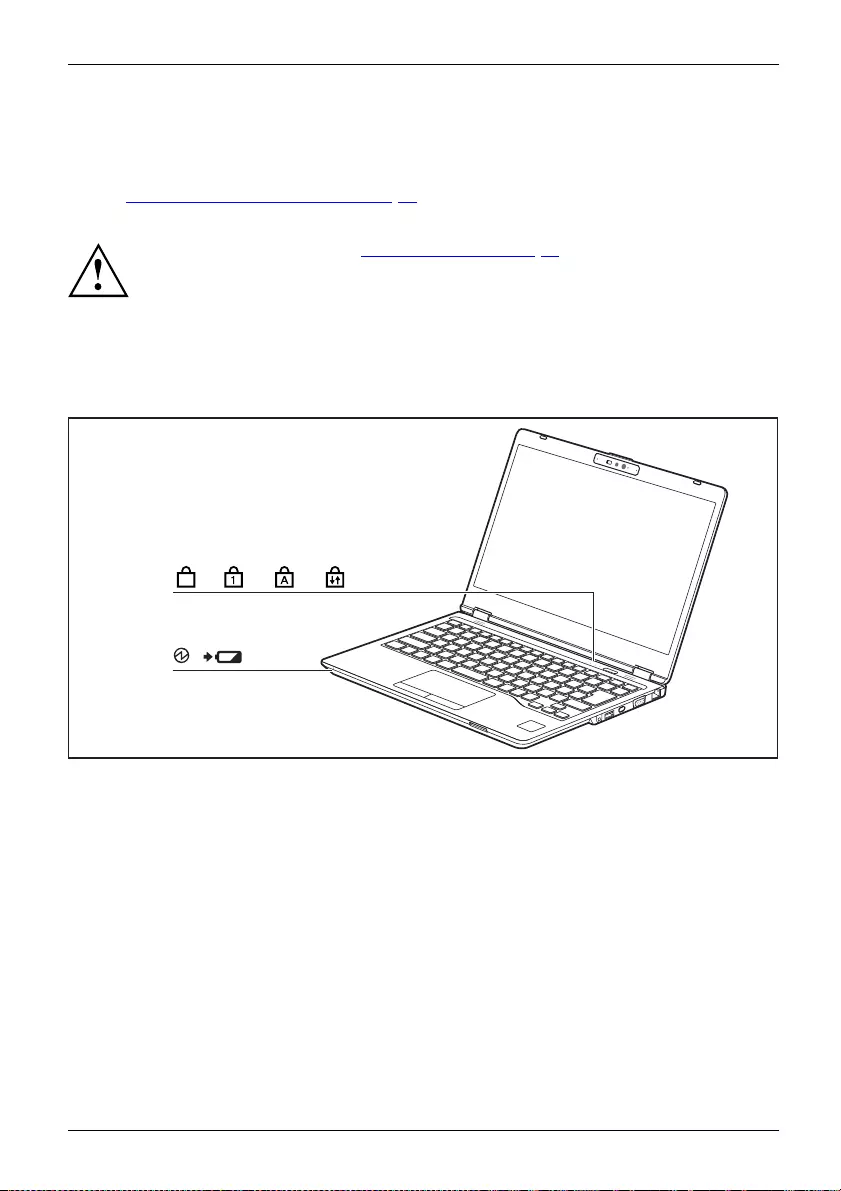
Working with the notebook
Working with the notebook
Notebook,operati onNotebook
This chapter describes the basics for operating your notebook. Please read the chapter
entitled "Connecting external devices", Page 55 for instructions on how to connect
devices such as a mouse and a printer to the notebook.
Please refer to the notes in "Important notes", Page 12.
Status indicators
Statusindicators
The status indicators provide information about the status of the power supply,
the hard disk and the keyboard functions.
F
Fujitsu 19

Working with the notebook
Indicator Description
Power-on indicator/Standby
StandbyindicatorPower-onindicator
• Indicator is illuminated: The notebook is switched on.
• Indicator flashes: The notebook is in standby mode.
• Indicator is off: The notebook is switched off.
Battery status indicator/mains connection
The state of charge of the battery is shown by the battery indicator.
1. With AC adapter connected:
• The indicator lights up orange: The battery is charging.
• The indicator is off: Charging is completed.
• The indicator flashes orange: The battery cannot be charged as the battery
is too hot or cold for charging. The charging process is continued as soon
as the battery reaches a permissible temperature again.
2. Running on battery (without AC adapter):
• The indicator is off: Battery level is 100-21%.
• The indicator lights up red: Battery level is 20-0%.
3. Battery abnormality/error:
The indicator flashes red.
BatterystatusindicatorBatterysymbolBatteryindicator
F
F Lock indicator
IndicatorFLock
The indicator lights up: The key combination Fn +Fhas been pressed.
Instead of the imprinted standard functions of the function keys, the Fn functions
can be executed by pressing the keys directly (see chapter "Function keys and
key combinations", Page 25).
Num Lock indicator
IndicatorNumLock
Indicator is illuminated: The Num key has been pressed. The virtual numerical
keypad is activated. You can output the characters indicated on the upper right of
the keys.
Caps Lock indicator
IndicatorCapsLock
Indicator is illuminated: The Caps Lock key has been pressed. All the characters
you type will appear in upper case. In the case of overlay keys, the character
printed on the upper left of the key will appear when that key is pressed.
Scroll Lock indicator
Indicator
ScrollLock
Indicator is illuminated: the key combination Fn +Scr has been pressed. The
effect that this key has varies between applications.
20 Fujitsu

Working with the notebook
Switching on the notebook
►Open the LCD screen.
Switchingon
►Press the ON/OFF button for about 1
second to switch the notebook on.
The power-on indicator is lit.
Notebook: switching off
Back up your data and close all applications before you switch off your
device. Otherwise data might be lost.
►Shut down the operating system correctly.
Notebook
►If the notebook does not switch itself off
automatically, press the ON/OFF button
for about 5-10 seconds.
►Close the LCD screen.
Fujitsu 21

Working with the notebook
Keyboard
KeyboardNumerickeypadNumeric keypadButtons
The keyboard of your notebook is subject to continuous wear through normal
use. The key markings are especially prone to wear. The key markings are
liable to wear away over the life of the notebook.
The keyboard has been designed to provide all the functions of an enhanced keyboard.
Some enhanced keyboard functions are mapped with key combinations.
The following description of keys refers to Windows. Additional functions supported by the keys
are described in the relevant manuals supplied with your application programs.
The figure below shows how to access the different characters on keys with overlaid functions.
The example applies when the Caps Lock key has not been activated.
The illustrations shown below may differ from your actual device.
0
=
}
+
+
Num
Alt Gr
=
0}
=
0}
=
0}
=
0}
22 Fujitsu

Working with the notebook
Key Description
Backspace key
The Backspace key deletes the character to the left of the cursor.
BackspaceBackspace
Tab key
The Tab key moves the cursor to the next tab stop.
Tabkey
Enter key (return)
The Enter key terminates a command line. The command you have entered
is executed when you pressthiskey.
EnterkeyReturnEnterLinef eed
Caps Lock key
The Caps Lock key activates the Caps Lock mode, and the corresponding
icon is displayed in the Windows information area. In Caps Lock mode, all
of the characters you type appear in upper case. In the case of overlay
keys, the character printed on the upper left of the key will appear when
that key is pressed. To cancel the Caps Lock function, simply press the
Caps Lock key again.
ShiftkeyCapsLock
Shift key
The Shift key causes uppercase characters to appear. In the case of overlay
keys, the character printed on the upper left of the key appears when that
keyispressed.
ShiftkeyShift
Fn key
The Fn key activates the Fn function of an overlay key (see chapter
"Function keys and key combinations", Page 25).
Fnkey
Cursor keys
The cursor keys move the cursor in the direction of the arrow, i.e. up, down,
left, or right.
CursorkeysCursorcontrol
Windows key
The Windows key switches between the start screen and the last used
application.
Windowskey
Menu key
The Menu key opens the menu for the active application.
Fujitsu 23

Working with the notebook
Virtual numeric keypad
NumerickeypadVir tualnum eric keypadNum Lock
To provide the convenience of a numeric keypad, your keyboard is equipped with a virtual
numeric keypad. The special keys of the virtual numeric keypad are recognisable by the numbers
and symbols printed in the upper right corner of each key. If you have switched on the virtual
numeric keypad, you can output the characters shown on the upper right of the keys.
The keyboard layout shown below may differ from your actual device.
1 = Valid characters when the Num
key is not activated
2 = Valid characters when the Num
keyisactivated
Further information about the status indicators can be found in chapter "Status indicators", Page 19.
Default settings
With default settings, each button must be pressed in combination with Fn in order
to enter the characters of the virtual numeric keypad.
In the BIOS setup utility, you can enable the function that allows you to enter the
characters of the virtual numeric keypad directly without Fn .
►To do so, in the Advanced-Keyboard Features menu select On or Off instead of On/Padlock Off.
With Windows, the Num Lock function can still be switched on and off using the
Num key regardless of whether On or Off is set in the BIOS.
24 Fujitsu

Working with the notebook
Function keys and key combinations
Keycombinations
The following description of the function keys and key combinations applies to Windows
operating systems. Some of the functions described below may not work in other
operating systems and with some device drivers.
Other key combinations are described in the relevant manuals supplied
with your application programs.
Key combinations are entered as follows:
►Press the first key in the combination and keep it pressed.
►While holding the first key down, press the other key or keys in the combination.
Function key Description
Switch microphone on/off
This function key switches the microphone off and on.
F1EnableDisable
Switching the loudspeakers on and off
Use this function key to switch your notebook’s loudspeakers off
and on.
F2LoudspeakersLoudspeakers
Decrease volume
This function key reduces the volume of the built-in loudspeakers.
F3Volume
Increase volume
This function key increases the volume of the built-in loudspeakers.
F4Volume
Switching the wireless components on / off
This function key switches the wireless components off or on.
F5Wirelesscomponents
Wirelesscomponents
Switching the touchpad and touchpad buttons on/off
This function key switches the touchpad and the touchpad buttons
off or on.
F6TouchpadTouchpadbuttons
Touchpad
Decrease screen brightness
This function key decreases the brightness of the screen.
F7LCDscreenScr eenbrightness
Increase screen brightness
This function key increases the brightness of the screen.
F8Screenbrightness
ePrivacy Filter
This function key activates or deactivates the optional side view
protection (see Section "ePrivacy Filter (optional)", Page 31).
F9ePrivacyFilter
Fujitsu 25

Working with the notebook
Function key Description
Toggle output screen
If an external monitor is connected, the screen on which the output
is to be displayed can be selected with this function key.
Screen output is possible:
• only on the notebook’s LCD screen
• on the LCD screen of the notebook and the external monitor
at the same time
• only on the external monitor
This setting is useful if you would like a high resolution and a
high refresh rate on an external monitor.
F10Toggleoutputs creen
Prt Scrn
This function key takes a screenshot of the current screen display
and saves it to the clipboard.
Num Lock
This function key activates the virtual number block. The
characters found on the upper right of the keys are then output.
Combination Description
Switch between open applications
Use this key combination to switch between several open
applications.
Alt+Tab
AltCtrl Del
++
Windows security/Task-Manager
This key combination opens the Windows security/Task-Manager
window.
Ctrl+Alt+Del
Back tab
This key combination moves the cursor back to the previous tab
stop.
Shift+TabBacktab
Key combinations using the Windows keys are detailed in the manual
for your operating system.
In addition, the following non-labelled key combinations are supported:
•Fn +S= Pause
•Fn +B= Break
•Fn +R= SysRq
26 Fujitsu

Working with the notebook
F-Lock setting
The F-Lock setting can be used to set either the hot keys or the function keys as
the primary function for the upper row of keys.
The F-Lock function is deactivated by default as delivered.
►F-Lock is turned on and off by pressing Fn +Esc .
When F-Lock is turned on, it remains activated like the Caps Lock key.
Changing the F-Lock setting changes the primary and secondary key functions as follows:
Status Hot Key Function key
F-Lock is deactivated
(F-Lock symbol is not
illuminated)
The hot key functions are
the primary behaviour:
►They are used by
simply pressing the
corresponding hot
key.
The function keys become
the secondary behaviour:
►They are used by
pressing Fn +the
function key.
F-Lock is activated
(F-Lock symbol is
illuminated)
The hot key functions are
the secondary behaviour:
►They are used by
pressing Fn + the hot
key.
The function keys become
the primary behaviour:
►They are used by
simply pressing
the corresponding
function key.
The F-Lock toggle function can be deactivated in the BIOS setup utility.
If the F-Lock toggle function is deactivated, the F-Lock symbol is continuously
on and the function keys become the primary function.
►To d o s o , i n t h e Advanced -Keyboard Features -F-Lock menu select disabled instead of enabled.
Keyboard with background lighting (optional)
KeyboardBackgroundlighting
On this version of the keyboard, repeated pressing of the key combination Fn +
space bar allows the background lighting to be switched on and off and also
a choice to be made between two levels of brightness.
In battery mode, it is recommended to turn on the backlight only when needed
and to use the lower brightness level to maximize battery life.
Country and keyboard settings
►Change the country and keyboard settings as described in the documentation for your operating
system.
Fujitsu 27
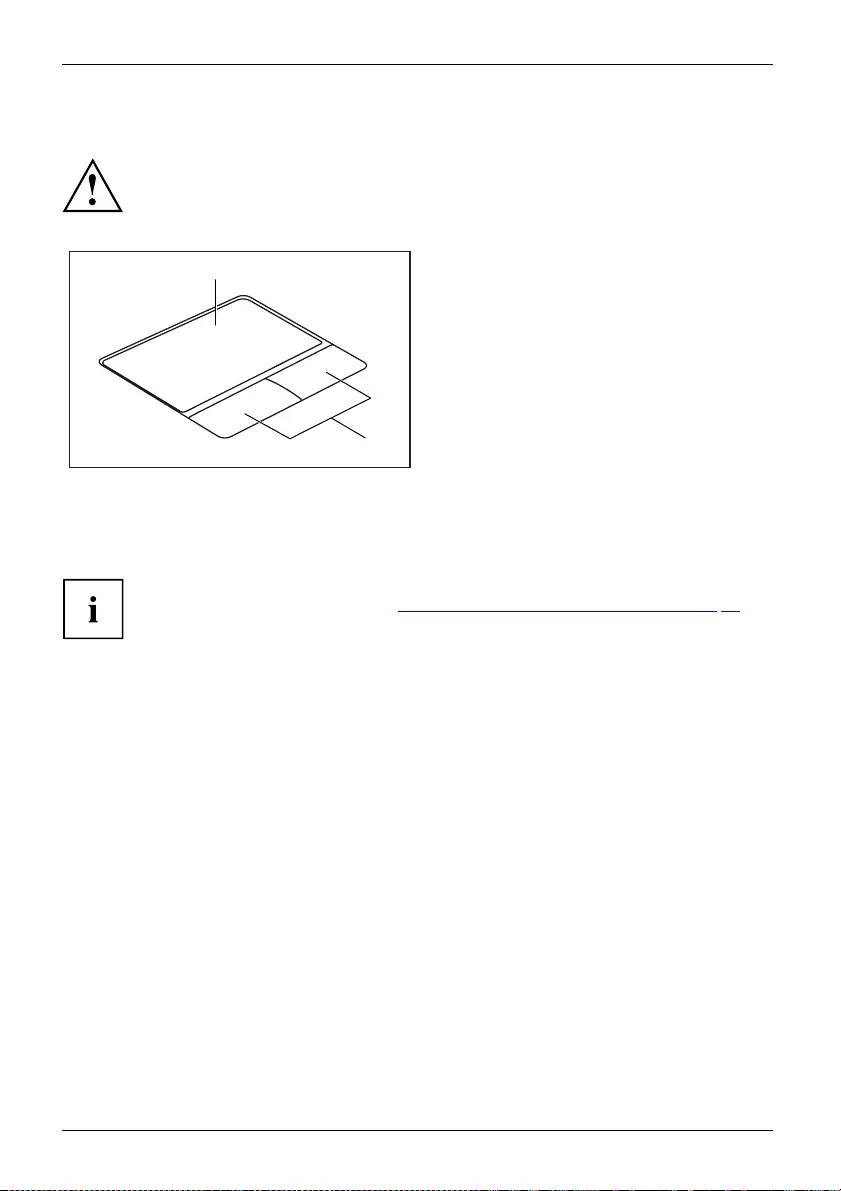
Working with the notebook
Touchpad and touchpad buttons
Keep the touchpad clean. Protect it from dirt, liquids and grease.
TouchpadTouchpad
Never use the touchpad if your fingers are dirty.
Do not rest heavy objects (e.g. books) on the touchpad or the touchpad buttons.
1
2
1 = Touchpad
2 = Touchpad buttons
You can move the cursor using the touchpad.
The touchpad buttons allow you to select and execute commands. They correspond
to the buttons on a conventional mouse.
You can also deactivate the touchpad via the keyboard, so that you cannot move the
cursor unintentionally (see chapter "Function keys and key combinations", Page 25).
Moving the pointer
►Move your finger on the touchpad.
Touchpad
The pointer will move.
Selecting an item
►Move the pointer to the item you wish to select.
Touchpad
►Tap the touchpad once or press the left button once.
The item is selected.
Executing commands
►Move the pointer to the field you wish to select.
Touchpad
►Tap the touchpad twice or press the left button twice.
The command is executed.
28 Fujitsu

Working with the notebook
Dragging items
►Select the desired item.
Touchpad
►Press and hold the left button and, with your finger on the touchpad, drag
the item to the desired position.
The item will be moved.
Touchscreen/LCD screen without touch
function (device-dependent)
LCDscreenNotes
High-quality LCD screens (TFT) are installed in Fujitsu notebooks. For technical reasons,
these screens are manufactured for a certain resolution. An optimum and sharp image can
only be ensured with the resolution intended for the particular screen. A screen resolution
which differs from the specification can result in an unclear picture.
The resolution of your notebook’s screen is optimally set at the factory.
With the present standards of production technology, absolutely flawless screen images
cannot be guaranteed. There may be a few constantly light or dark pixels (picture
elements) on the screen. The maximum permitted number of such faulty pixels is
specified in the international standard ISO 9241-307 (Class II).
Example:
A screen with an HD resolution of 1366 x 768 has 1366 x 768 = 1049088 pixels. Each pixel consists
of three subpixels (red, green and blue), making a total of about 3 million subpixels. According to ISO
9241-307 (class II), a maximum of 2 light and 2 dark pixels and in addition 5 light or 10 dark subpixels
or an equivalent mix (1 light subpixel counts as 2 dark subpixels) are allowed to be defective.
Pixel A pixel consists of 3 subpixels, normally red, green and
blue. A pixel is the smallest element that can be generated
by complete functionality of the display.
Subpixel A subpixel is a separately addressable internal structure
within a pixel that enhances the pixel function.
Cluster A cluster contains two or more defective pixels or
subpixels in a 5 x 5 pixel block.
Background lighting
LCD screens are operated with background lighting. The luminosity of the background
lighting can decrease during the period of use of the notebook. However, you
can set the brightness of your screen individually.
Synchronising the display on the LCD screen and an external monitor
For more information, please refer to the chapter "Function keys and key combinations",
Page 25 under "Display output, switch between".
Fujitsu 29

Working with the notebook
Using fingers
You can use your finger on the touch screen of your device to execute
commands and start applications.
Action Description
Tapping ►Tap on a symbol, menu, button or folder to
selectthisoptionortoactivateit.
Type, hold, release ►Type and hold a symbol and release it again.
The selected action is performed.
Dragging ►Tap and hold a symbol and drag it to another
place.
You can for instance drag apps or widgets onto
the home page in this way.
Double-tap ►To enlarge a view, quickly tap twice on a
web page, map or another screen.
When you double-taponanimageinaweb
browser, it will be enlarged and another
double-tap will make it smaller again.
Zoom in/Zoom out ►With some apps, you can enlarge the
display size by moving two fingers apart on
the touchscreen, and reduce it by moving
your fingers together.
Input fields Data must be entered for some apps, for
instance an Internet page or your name and
password.
►Tapontheinputfield.
An on-screen keyboard opens, with which you
can enter your data.
30 Fujitsu

Working with the notebook
WebCam and Infrared Camera
Webcam
Depending on the device version, your device may have an integral
Webcam with microphone.
Depending on the variant, the device contains an infrared camera instead of the
webcam, enabling authentication with Microsoft Windows Hello.
Depending on the software used, you can use your Webcam to take pictures,
record video clips or take part in web chats.
The WebCam has its own status indicator. The indicator lights up when the WebCam is switched on.
The webcam has a sliding shutter with which the camera can be covered.
• The picture quality depends on the lighting conditions and the software being used.
• You can only operate the webcam with a particular application (e.g. an Internet telephony
program or a video conferencing program which supports a webcam).
• When using the webcam the notebook support must not wobble.
• The webcam automatically adjusts itself to the current light level. For this reason
the LCD screen may flicker while the light level is adjusted.
Further information on using the webcam and on the additional settings
which are possible for your webcam can be found in the help function
of the program which uses the webcam.
ePrivacy Filter (optional)
If your monitor is equipped with the optional electronic privacy filter, you can activate and deactivate
it by pressing the F9 key. This can be used to restrict the possible side viewing angle for the monitor.
This feature can also be permanently enabled or disabled In the BIOS setup utility under
Advanced - Internal Device Configurations - ePrivacyFilter. In this case it is no longer
possible to switch the function on and off with the F9 key.
Fujitsu 31

Working with the notebook
Rechargeable battery
RechargeablebatteryBatteryLife,batteryRechargeablebatteryRechargeablebattery
When not plugged into a mains socket, the notebook runs on its built-in battery. You
can increase the life of the battery by caring for the battery properly. The average
battery life is around 500 charge/discharge cycles.
You can extend the battery life by taking advantage of the available energy saving functions.
Charging, caring for and maintaining the battery
BatteryBattery
The notebook’s rechargeable battery can only be charged when the ambient temperature
is between 5°C / 41°F and max. 35°C / 95°F.
You can charge the battery by connecting the notebook to the mains adapter
(see "Mains adapter connecting", Page 17).
Please note that the battery will not be charged if the battery state of charge is
between 90% and 100%. If the battery state of charge is less than 90% and the mains
adapter is connected, the battery will be charged to 100%.
When the battery state of charge is low, a message from the operating system appears.
If you do not connect the mains adapter within about 5 minutes of the message
appearing, your notebook will automatically switch off.
monitoring the battery charging level
BatteryBatterystatusmeter
Windows also has a "Battery status meter" in the taskbar for monitoring the battery capacity. When
you place the mouse pointer on the battery symbol, the system displays the battery status.
Storing the battery
BatteryBatterySelf-discharge,battery
chargingcapa city,battery
Store battery packs in a dry environment at a temperature between 0°C / 32°F and 30°C / 86°F. The
lower the temperature at which the batteries are stored, the lower the rate of self-discharge.
If you will be storing batteries for a longer period (more than two months),
the battery charge level should be approx. 30 %. To prevent exhaustive
discharge which would permanently damage the battery, check the level
of charge of the battery at regular intervals.
To be able to make use of the optimal charging capacity of the batteries, the battery
should be completely discharged and then fully recharged.
If you do not intend to use a battery for long periods of time, remove it from
the notebook. Never store a battery in the device.
If the device will not be used for a period of more than two days, remove the
batteries from the device so that their state of charge is maintained.
32 Fujitsu

Working with the notebook
Removing and installing the battery
Only use batteries approved by Fujitsu for your notebook.
Never use force when fitting or removing a battery.
Make sure that no foreign bodies get into the battery connections.
Never store a battery for long periods in the discharged state. This
can make it impossible to recharge.
Removing a battery
Please adhere to the safety information in chapter "Important notes", Page 12.
Remove the power plug from the mains socket!
►Switch the device OFF.
The device must not be in power-saving mode!
►Close the LCD screen.
►Remove all the cables from the device.
►Turn the device over and place it on a stable, flat and clean surface. If necessary, place
an anti-slip cloth on this surface to prevent the device from being scratched.
a
1
2
1 HOLD
3 PULL UP
2
3
►Slide the locking device (1) in the direction of the arrow and hold it in place.
►Slide the locking device (2) in the direction of the arrow.
►Grasp the opening (b) and lift the battery out of the battery compartment
in the direction of the arrow (3).
Fujitsu 33

Working with the notebook
Installing a battery
22
1
►Position the battery at the edge.
►Insert the battery into the battery compartment until it engages positively (1)
►Slide the locking device (2) in the direction of the arrow.
►Turn the notebook the right way up again and place it on a flat surface.
►Reconnect the previously disconnected cables.
34 Fujitsu

Working with the notebook
Using the power-management features
PowerPowerBattery
The notebook uses less power when the available power-management features are used. You
will then be able to work longer when using the battery before having to recharge it.
Power efficiency is increased and environmental pollution reduced. By
choosing the best power options, you can make significant savings and
at the same time help protect the environment.
When you close the LCD screen, depending on the setting in Windows, the
notebook automatically enters a power saving mode.
►Select the power management functions in your Control Panel.
If you need further information about an option, you can get help about most settings
by pressing the key combination Fn +F1 to show the Microsoft help.
When the notebook is in power-saving mode, the following must be remembered:
During power saving mode, open files are held in the main memory
orinaswapfile on the hard disk.
Never turn off your notebook while it is in a power saving mode. If the built-in battery is
nearly empty, close the open files and do not go into power saving mode.
If you do not intend to use your notebook for a long period of time:
►Exit power saving mode if necessary via the mouse or keyboard or by switching on the
notebook.
►Close all opened programs and completely shut down the notebook.
Fujitsu 35

Working with the notebook
Adjusting fan control
You can adjust the fan control in the BIOS Setup Utility. The following settings are available:
• Normal: The system is cooled to ensure that the maximum system performance is always
available and to keep the housing temperature as low as possible.
• Silent: The fan rotation speed, and therefore the noise created by the fan, is reduced.
►Call up the BIOS Setup Utility.
►In the menu Advanced - Miscellaneous Configurations select the Fan Control function.
►Choose the setting Normal or Silent.
Instructions for how to call up and operate the BIOS-Setup-Utility can be found
in chapter "Settings in BIOS Setup Utility", Page 63.
With the Fujitsu Utility Function Manager you can also switch between these two
settings with Windows. In the Function Manager, select the Fan menu item with
the options Quiet Mode (corresponds to Silent)andNormal Mode.
36 Fujitsu

Working with the notebook
Memory cards
Slot
Your notebook is equipped with an integrated memory card reader.
Observe the manufacturer’s instructions when handling the memory cards.
Memorycard
Supported formats
Your notebook supports the following format:
• Secure Digital (SDTM card)
Inserting the memory card
►Carefully push the memory card into the
slot until you feel it click into place. The
label area must be facing upward. Do not
apply any force, otherwise the delicate
contact surfaces could be damaged.
Memorycard
Depending on the particular type
used, the memory card may protrude
slightly from the slot.
Removing the memory card
Memorycard
In order to protect your data, always follow the correct procedure for removing
the card (see the documentation for your operating system).
1
2
►On devices with card locking: Press
on the memory card (1).
Memorycard
The memory card is released and
can now be removed.
►Pull the memory card out of the slot (2).
Fujitsu 37

Working with the notebook
Loudspeakers and microphones
MicrophoneLoudspeakersVolum ec ontro l
You will find information about the exact position of speakers and microphones
in chapter "Ports and controls", Page 9.
Please refer to chapter "Function keys and key combinations", Page 25 for information on setting
the volume and also enabling/disabling the loudspeakers via the keyboard.
If you attach an external microphone, the built-in microphone is disabled.
When you connect headphones or external speakers, the built-in speakers are disabled.
Information on connecting headphones and a microphone can be found
in "Connecting external devices", Page 55.
38 Fujitsu

Working with the notebook
SIM card (configuration dependent)
Your device supports cards in Nano-SIM format.
A SIM Card (Subscriber Identity Module) is a chip card which is inserted in a mobile telephone or
notebook and, together with an integrated LTE module, enables access to a mobile radio network.
Follow the instructions supplied by the provider of the SIM card.
The SIM card slot is located in the battery compartment and can only
be accessed when the battery is removed.
Inserting the SIM card
►Remove the battery, see "Removing a battery", Page 33.
1
2
►Pull the SIM card holder out of the slot (1).
►Insert the SIM card (2) into the SIM card holder as shown in the diagram on the SIM card holder.
Fujitsu 39

Working with the notebook
2
3
►Remove the SIM card from the SIM card holder (2).
►Push the SIM card holder back into the slot (3).
►Install the battery again, see "Installing a battery", Page 34.
Wireless components Wireless LAN / Bluetooth / LTE
The installation of radio components not approved by Fujitsu will invalidate
the certifications issued for this device.
Switching the wireless components on and off
►Press the key with the radio symbol to switch the wireless components on and off (flight
mode).
WirelessLANWirelessLANBluetoothBluetooth
If you switch off the radio components, the wireless LAN antenna and the
Bluetooth and LTE module will also be switched off.
Pay attention to the additional safety notes for devices with wireless components
provided in the "Safety/Regulations" manual.
You can obtain more information on LTE from your service provider.
Fujitsu 41

Working with the notebook
Setting up WLAN access
• Requirement: A WLAN must be available and you must have the
corresponding access information.
Information on configuring the WLAN access can be found in the
documentation for your operating system.
Access via LTE
You can purchase the accessories for LTE reception from your retailer
or your Fujitsu Technology Solutions dealer.
If you have ordered an LTE module, your device will already be
prepared when you receive it.
You will find information on establishing the connection with the LTE network
in the documentation for the hardware you are using.
Your device can connect with the Internet via the LTE module. To do this,
use one of the following types of connection:
• USB dongle
a USB stick with your mobile phone provider’s SIM card
• a mobile end-device (e.g. mobile phone) with Bluetooth connection
• a mobile end-device (e.g. mobile phone) with data cable
42 Fujitsu

Working with the notebook
Ethernet and LAN
EthernetLAN
The internal network module of your notebook supports Ethernet LAN. You can use it to
establish a connection to a local network (LAN = Local Area Network).
2
1
►Connect the network cable to the LAN
port of the notebook (1).
►Connect the network cable to your
network connection (2).
Your network administrator can help you to configure and use the LAN connections.
The network cable is not included in the delivery scope. This type of
cable can be obtained from a specialist dealer.
Use a shielded network cable (CAT 5e).
Fujitsu 43

Working with the notebook
Your Port Replicator
The Port Replicator is a device that helps you to quickly connect your notebook to
your peripheral devices, such as a monitor, printer etc.
The features offered by the Port Replicator include standard ports for
monitor, audio, mouse and keyboard.
You need only dock the notebook in order to work with your peripheral devices.
In addition to the port replicator with mechanical docking described here, this system
also supports optionally available USB Type-C or Thunderbolt port replicators that
are connected to the system via the USB Type-C connector.
Ports on the Port Replicator
PortReplicatorPorts
13
1
2
3
12
11
10
9
8
7
6
5
4
1 = Headphone jack (left), microphone
jack (right)
2 = ON/OFF button
3 = Connector on the Port Replicator for the
docking port on the bottom of the notebook
4 = Key lock (optional)
5 = Unlocking lever
6 = DC jack socket (DC IN)
7 = USB 3.2 Gen1 port with charging
function (USB Type-C™)
8 = USB port 3.2 Gen1 (USB Type-A)
9 = Displayports
10 = DVI-D monitor port
11 = VGA monitor port
12 = LAN port
13 = Security Lock device
The DVI port and the neighbouring Displayport cannot be used at the same time.
44 Fujitsu
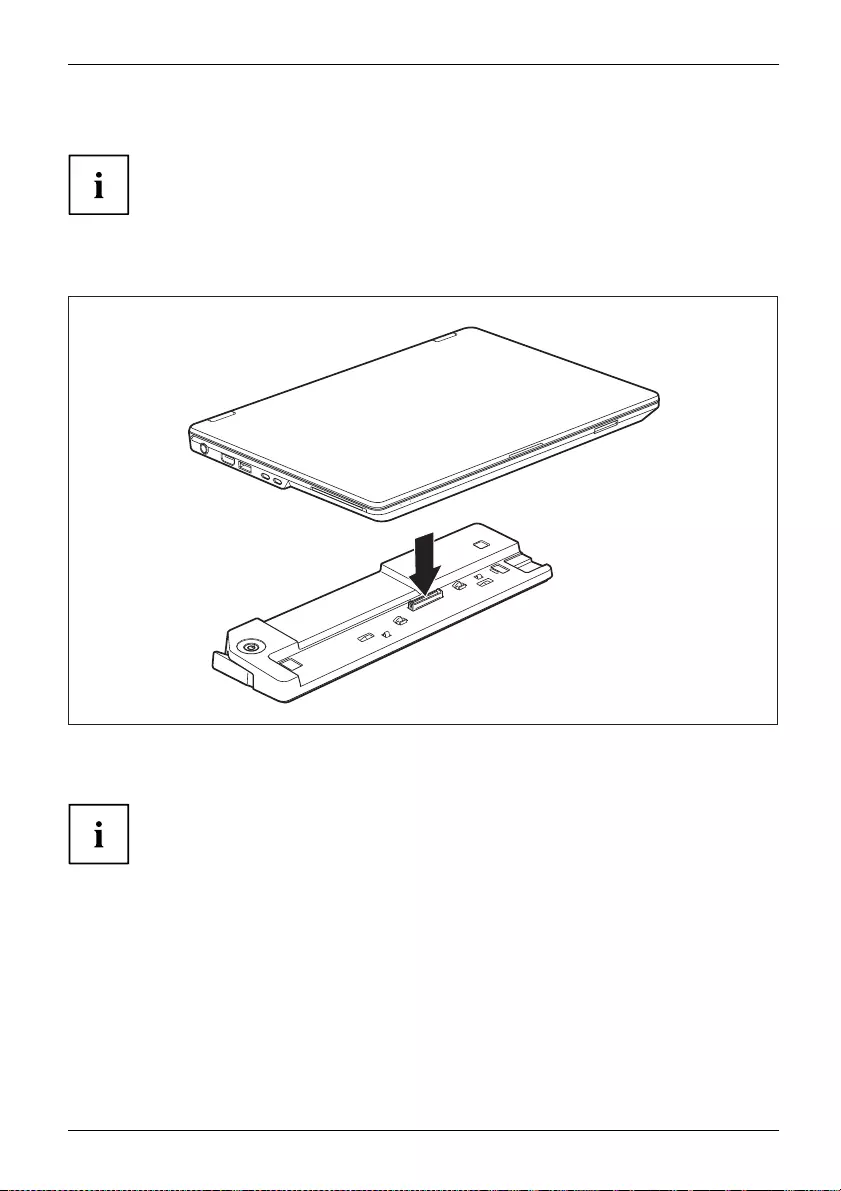
Working with the notebook
Connecting the notebook to the Port Replicator
The mains adapter must be connected to the Port Replicator when the
notebook is connected to the Port Replicator.
We recommend that the notebook is not operated with the LCD screen closed when
the notebook is connected to the Port Replicator. The resulting overheating can
cause reduced performance and increased activity of the integrated fan.
PortReplicator
►Disconnect the mains adapter cable from the DC socket (DC IN) of the notebook.
1
►Position the notebook so that it is in line with the back edge of the Port Replicator.
►Place the notebook onto the Port Replicator (1) and ensure that it locks into place correctly.
If necessary, secure the notebook and port replicator by closing the
key lock on the port replicator.
Fujitsu 45

Working with the notebook
Connecting the mains adapter to the Port Replicator
3
1
2
►Connect the power cable (1) to the power
adapter provided for the device, see
chapter "Technical data", Page 77.
►Plug the power cable into the mains
socket (2).
►Connect the mains adapter cable to the DC
jack (DC IN) of the Port Replicator (3).
When the notebook is connected to a Port Replicator, the operating system creates
a hardware profile for the "Docked" mode. In this profile, for example, the setting is
saved as to which monitor was last used for output. This profile will be loaded, as
soon as the notebook is connected to a Port Replicator of the same type.
Switching on the notebook via the port replicator
►Press the ON/OFF button on the port
replicator to switch the notebook on.
The power-on indicator of the Port
Replicator lights up.
46 Fujitsu

Working with the notebook
Disconnecting the notebook from the Port Replicator
3
1
2
►Turn the key in the direction of the arrow (1) to unlock the port replicator.
►Pull the unlocking lever in the direction of the arrow (2), until you hear the notebook unlatch.
►Lift off the notebook (3).
Fujitsu 47
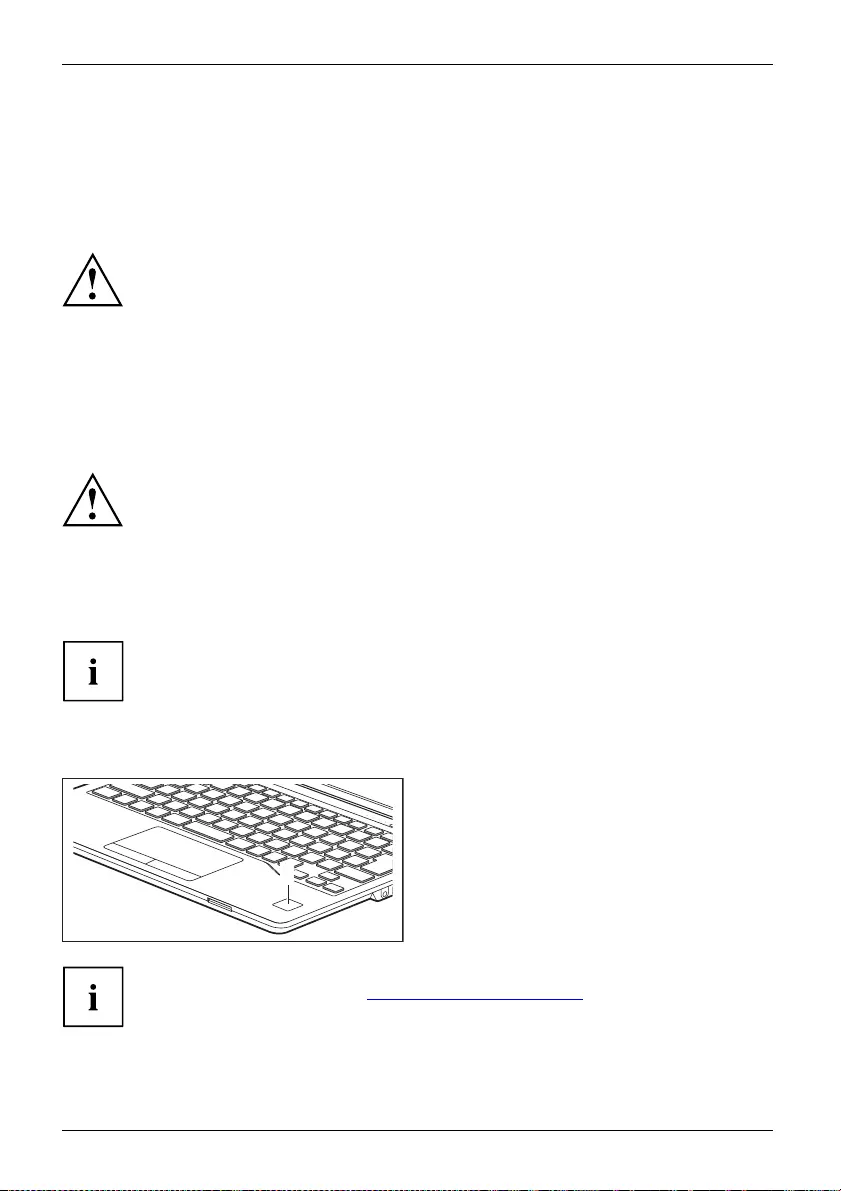
Security functions
Security functions
Securityfunctions
Your notebook has several security features that you can use to secure your
system from unauthorised access.
This chapter explains how to use each function, and what the benefits are.
Please remember that in some cases, for example, forgetting your password,
you may be locked out and unable to access your data. Therefore,
please note the following information:
• Make regular backups to external data carriers such as external hard
drives, CDs, DVDs or Blu-ray Discs.
• Some security functions need you to choose passwords. Make a note
of the passwords and keep them in a safe place.
If you forget your passwords you will need to contact the our Service
Desk. Deletion or resetting of passwords is not covered by your warranty
and a charge will be made for assistance.
If you change the Password Severity setting from Strong to Stringent in the Security
BIOS Setup Utility menu, the Fujitsu Service Desk can no longer reset the password.
In this case, the system can remain permanently unusable.
Therefore, Fujitsu recommends to generally set up a supervisor password
with the setting Password Severity =Strong.
Configuring the fingerprint sensor
Fingerprintsens orFingerprintsens or
Whether or not your device has a fingerprint sensor depends on the
device configuration you have ordered.
The fingerprint sensor can record an image of a fingerprint. With additional fingerprint
software, this image can be processed and used instead of a password.
1
►You must install the fingerprint software
in order to be able to use the
fingerprint sensor (1).
The current AuthConductor Client Basic software for hand vein and fingerprint sensor
is available on the Internet at "https://support.ts.fujitsu.com/"
After selecting the product and the operating system, you will find the software
under Downloads, Applications, Tools and Utilities.
48 Fujitsu

Security functions
Configuring the palm vein sensor
PalmveinsensorPalmveinsensor
Whether your device has a palm vein sensor depends on the device
configuration you have ordered.
The palm vein sensor can record the image of the pattern of the veins of the hand. This image
is evaluated by additional software and can be used instead of a password.
1
►To be able to use the palm vein sensor
(1), you must install the software.
The current AuthConductor Client Basic software for hand vein and fingerprint sensor
is available on the Internet at "https://support.ts.fujitsu.com/"
After selecting the product and the operating system, you will find the software
under Downloads, Applications, Tools and Utilities.
Using the Security Lock
Your device comes with a Security Lock mechanism for the Kensington Lock Cable. You
can use the Kensington Lock Cable, a sturdy steel cable, to help protect your notebook
from theft. The Kensington Lock Cable is available as an accessory.
Fujitsu recommends the use of a combination lock.
K
►Fit the Kensington Lock Cable to the
mechanism on your notebook.
UsingtheKensingtonLockCableSecurity LockMechanicalbackupAnti-theftpr otection
Attach another Kensington Lock Cable to your Port Replicator to protect
your Port Replicator from theft as well.
Fujitsu 49

Security functions
Configuring password protection in BIOS Setup Utility
Before using the various options for password protection in the BIOS Setup utility
to increase data security, please observe the following:
Make a note of the passwords and keep them in a safe place. If you forget your
supervisor password you will not be able to access your notebook. Deletion of the
password is not covered by your warranty and a charge will be made for assistance.
Password protectio n
Your password can be up to 32 characters long and can contain
letters, numbers and special characters.
When using special characters, you must remember that these are dependent
on the country variants of the keyboard used.
If you change the Password Severity setting from Strong to Stringent in the Security
BIOS Setup Utility menu, the Fujitsu Service Desk can no longer reset the password.
In this case, the system can remain permanently unusable.
Therefore, Fujitsu recommends to generally set up a supervisor password
with the setting Password Severity =Strong.
Protecting BIOS Setup Utility (supervisor and user password)
If you have opened these operating instructions on the screen, we
recommend that you print them out. You cannot call the instructions onto
the screen while you are setting up the password.
BIOSSetupUtility
The supervisor password and the user password both prevent unauthorised use of the BIOS Setup
Utility. With the aid of the supervisor password you can access all of the functions of the BIOS
Setup Utility, while the user password will only give you access to some of the functions. You
can only set up a user password if a supervisor password has already been assigned.
Please refer to section "Settings in BIOS Setup Utility", Page 63 for a description
of how to call up and operate the BIOS-Setup-Utility.
50 Fujitsu

Security functions
Assigning the supervisor and user passwords
►Start the BIOS Setup Utility and go to the Security menu.
►Select the Set Supervisor Password field and press the Enter key.
With Enter new Password: you are asked to enter a password.
►Enter the password and press the Enter key.
Confirm new Password requires you to confirm the password.
►Enter the password again and press the Enter key.
Changes have been saved is a confirmation that the new password has been saved.
►To set the user password, select Set User Password and proceed exactly as
when configuring the supervisor password.
If you do not want to change any other settings, you can exit BIOS Setup Utility.
►In the Exit menu, select the option Save Changes & Exit.
►Select Yes and press the Enter key.
PasswordSupervisorpassword
Userpassword
The notebook is then rebooted and the new password comes into effect. It will now be necessary
to first enter your supervisor or user password in order to open the BIOS Setup Utility. Please
note that the user password only provides access to a few of the BIOS settings.
Changing the supervisor or user password
You can only change the supervisor password when you have logged into the
BIOS Setup Utility with the supervisor password.
PasswordSupervisorpasswordUserpassword
►Call the BIOS Setup Utility and go to the Security menu.
►When changing the password, proceed exactly as for password assignment.
Removing passwords
To remove a password (without setting a new password) perform the following steps:
PasswordSupervisorpassword
Userpassword
►Start the BIOS Setup Utility and go to the Security menu.
►Highlight the Set Supervisor Password or Set User Password field and press the Enter key.
You will be requested to enter the current password by the Enter Current Password prompt.
You will be requested to enter a new password by the Enter New Password prompt.
►Press the Enter key twice.
►In the Exit menu, select the option Save Changes & Exit.
►Select Yes and press the Enter key.
The notebook will now reboot with the password removed.
Removing the supervisor password simultaneously deactivates the user password.
Fujitsu 51

Security functions
Password protection for booting of the operating system
With the supervisor password you have set in the BIOS Setup Utility (see
section "Assigning the supervisor and user passwords", Page 51), you can
also prevent starting of the operating system.
Operating system
Activating system protection
►Start the BIOS Setup Utility and go to the Security menu.
Operatingsystem
►Select the Password on Boot option and press the Enter key.
►Select the desired option (Disabled,First Boot or Every Boot) and press the Enter key
►Select the Save Changes & Exit option under Exit.
The notebook reboots. You will be prompted to enter your password (the supervisor password).
Deactivating system protection
►Start the BIOS Setup Utility and go to the Security menu.
Operatingsystem
►Select the Password on Boot option and press the Enter key.
►Select the Disabled option and press the Enter key.
If you do not want to change any other settings, you can exit BIOS Setup Utility.
►Select the Save Changes & Exit option under Exit.
The notebook will reboot. The system is no longer password-protected.
Password protection for the hard disk
If a supervisor password has been assigned, a password for the hard disk can
also be set in the Hard Disk Security menu.
The hard disk is protected by this password. Data on this hard disk can only be read
into another system if the correct password has been entered.
52 Fujitsu

Security functions
Trusted Platform Module (TPM) (device-dependent)
TPMTrustedPlatform Module
To use the TPM, you must activate the TPM in the BIOS Setup before the software
is installed. The condition for this is that you have assigned at least the supervisor
password (see "Security functions", Page 48).
Instructions on how to call up and use the BIOS Setup Utility can be found in
section "Settings in BIOS Setup Utility", Page 63.
Enabling TPM
• Requirement: You have set a supervisor password, see "Security functions", Page 48.
►Call up the BIOS Setup and select the Security menu.
►Mark the TPM (Security Chip) Setting field and press the Enter key
►Select the "Security Chip" "Enabled" entry to activate the TPM
Once you have activated the TPM through a reboot, the Clear Security Chip menu option appears.
With Clear SecurityChip, you can delete the owner in the TPM, if the TPM has already
been used. With Enabled, all secret keys generated by applications (e.g. SRK - Storage
Root Keys, AIK - Attestation Identity Keys, etc.) are deleted.
Please note that you will then no longer be able to access the data you have
encrypted with the keys based on that holder.
►Select the Exit Saving Changes option in the Exit menu.
►Press the Enter key and select Yes.
The notebook will restart, and TPM will be enabled after the reboot.
Disabling TPM
• Requirement: You have set a supervisor password, see "Security functions", Page 48.
►Call up the BIOS Setup and select the Security menu.
►Mark the TPM (Security Chip) Setting field and press the Enter key.
►Select the "Security Chip" "Disabled" entry to deactivate the TPM
►From the Exit menu, choose the option Exit Saving Changes.
►Press the Enter key and select Yes.
Your notebook will now restart and TPM will be disabled.
Fujitsu 53
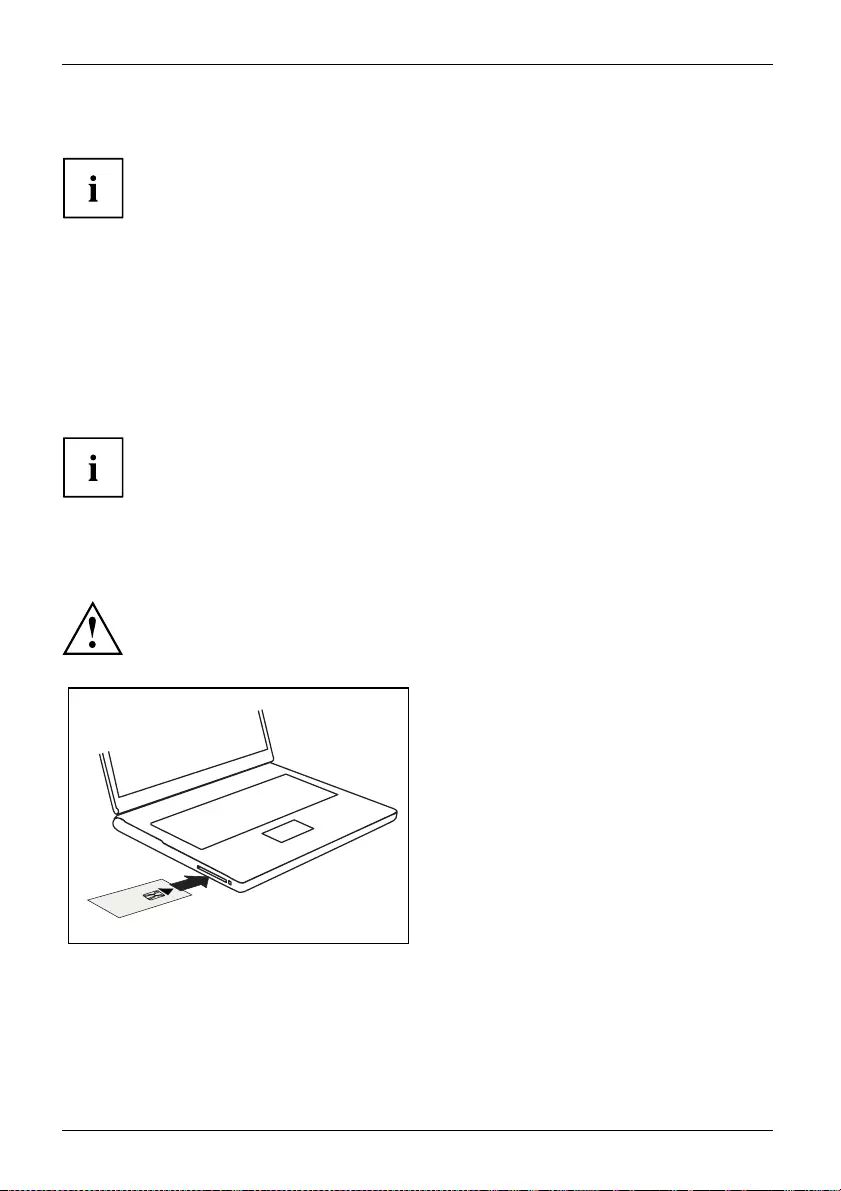
Security functions
SmartCard reader
Securityfunctions,Securityfunctions
Depending on the device configuration, your notebook may be equipped
with a SmartCard reader.
SmartCards are not supplied as standard equipment. You can use all SmartCards that comply with
the ISO standard 7816-1, -2 or -3. These SmartCards are available from various manufacturers.
With the appropriate software you can use your SmartCard as an alternative to password protection,
but also as a digital signature, for encrypting your e-mails or for home banking.
We recommend that you always use two SmartCards. Always keep one of the SmartCards
in a safe place if you are carrying the other SmartCard with you.
In order to be able to take advantage of all the security features of your notebook,
you will need a CardOS SmartCard from Fujitsu.
The SmartCard can only be used with a PIN, offering maximum protection even if
you lose the SmartCard. In order to maximise your security, the CardOS SmartCard
is disabled if three incorrect attempts are made to enter the PIN.
When you use the CardOS SmartCard for the first time, you will either need to enter the
preset PIN "12345678" or the PIN given to you by your systems administrator.
Inserting the SmartCard
Do not use force when inserting and removing the SmartCard.
Make sure that foreign objects do not fall into the SmartCard reader.
►Slide the SmartCard into the SmartCard
reader with the chip facing upwards (on
some variants it faces down) and to the front.
54 Fujitsu

Connecting external devices
Connecting external devices
Always refer to the safety information provided in "Important notes", Page 12 before
connecting or disconnecting any devices to or from your notebook.
Always read the documentation supplied with the device you wish to connect.
Never connect or disconnect cables during a thunderstorm.
Never pull at a cable when disconnecting it. Always grasp the plug.
With some devices such as USB devices, it is not necessary to switch off
the notebook and the device before connecting/disconnecting. For more
information about whether or not devices need to be switched off, please refer
to the documentation supplied with the external device.
Some of the external devices require special drivers (see the operating
system and external device documentation).
Fujitsu 55

Connecting external devices
Connecting an external monitor
An analogue monitor is connected to the analogue VGA monitor port, a digital monitor to the
display port or the DVI-D monitor port on the optional port replicator.
The HDMI port of your notebook can be used to connect an external amplifier,
LCD TV or a plasma TV with an HDMI connection.
The screen output is limited to a maximum of two screens at the same time (see "Function
keys and key combinations", Page 25, section "Changing the screen output").
MonitorVGAcon nection socketMonitorportMonitorport
Digital display port (on the optional port
replicator)
Analogue VGA monitor port (on LIFEBOOK or
optional port replicator)
Digital DVI-D monitor port (on the optional Port
Replicator)
Digital HDMI port (on LIFEBOOK)
►Switch off the notebook and the external monitor.
►Plug the data cable of the external monitor into the monitor port.
►First switch on the external monitor and then the notebook.
56 Fujitsu

Connecting external devices
You can also switch between the external monitor and the LCD monitor of the
notebook, see chapter "Function keys and key combinations", Page 25.
You can display the same picture on the external monitor and the
notebook LCD monitor simultaneously.
If you wish to operate the monitor via a DVI port, use the optional Port
Replicator available for your notebook.
Fujitsu 57

Connecting external devices
Connecting USB devices
USBports
On the USB ports, you can connect external devices that also have a USB port
(e.g. a DVD drive, a printer, a scanner or a modem).
USB devices are hot-pluggable. This means you can connect and disconnect
devices while your operating system is running.
USB 1.x has a maximum data transfer rate of 12 Mbit/s.
USB 2.0 has a data transfer rate of up to 480 Mbit/s.
USB 3.0 has a data transferrateofupto5Gbit/s.
USB 3.2 (Gen1) has a data transfer rate of up to 5 Gbit/s.
USB 3.2 (Gen2) has a data transfer rate of up to 10 Gbit/s.
Additional information can be found in the documentation for the USB devices.
►Connect the data cable to the
external device.
►Connect the data cable to a USB
port of the notebook.
Device drivers
USB devices will be automatically recognised and installed by your operating system.
58 Fujitsu

Connecting external devices
USB port Intel® ThunderboltTM 4 with charging function
and display port (USB Type-C)
USB-AnschlussmitAufladefunktion(USBType-C)IntelThunderbolt
At this USB port, you can charge a connected USB device or operate devices
without additional power supply.
This is also possible with connected notebook computers by going to the BIOS Setup Utility
under the menu Advanced > Miscellaneous Configurations and activating the function USB Type-C
Power Delivery on System-Off. Instructions for how to call up and operate the BIOS Setup
Utility can be found in section "Settings in BIOS Setup Utility", Page 63.
With the USB Type-C Port Replicator available as an accessory, the notebook
can be supplied with power via this USB port.
USB devices are hot-pluggable. This means you can connect and disconnect
the cables of USB devices while the system is running.
Additional information can be found in the documentation for the USB devices.
►Connect the data cable to the
external device.
►Connect the data cable to the USB port
Intel® ThunderboltTM 4 with charging
function and display port (USB Type-C)
of the notebook.
Fujitsu 59

Connecting external devices
USB port with charging function (Anytime USB charge)
You can use this USB port to charge or supply power to a connected USB device (e.g.
to charge a PDA or a mobile phone or to connect a USB lamp).
Charging is also possible when the notebook is switched off, if the Anytime USB Charge function
is activated in the Advanced menu of the BIOS Setup Utility. If the setting AC is selected,
the device will only be charged when the mains adapter is connected.
Please refer to section "Settings in BIOS Setup Utility", Page 63 for a description
of how to call up and operate the BIOS-Setup-Utility.
USBchargingfunction
It is recommended that the notebook be operated with the power supply connected
whenever the USB port with charging function is in use, as this function will drain
the battery more quickly if an external USB device is being charged.
The power supply unit must already be connected when the notebook is
switched off, as otherwise the USB charging function will be disabled and
the connected USB devices will not be charged.
Some USB devices (e.g. mobile telephones) require a driver in order to utilise the
USB charging function. In this case the USB charging function will not work when the
notebook is switched off, as no drivers are active when the notebook is switched off.
►Connect the data cable to the
external device.
►Connect the data cable to a USB port
(Anytime USB charge) of the notebook.
How to remove USB devices correctly
Always correctly remove the device according to the rules described below,
to ensure that none of your data is lost.
►Left click on the icon to safely remove hardware, located in the taskbar.
►Select the device which you want to shut down and remove.
►Press the Enter key.
Wait for the dialogue box which tells you that it is now safe to remove the device.
60 Fujitsu

Connecting external devices
Headset port
Connectingaudio dev icesAudioportsConnectingheadphones
The headset port lets you connect a headset, headphones, external speakers
or microphones to your notebook.
►Connect the audio cable to the
external device.
►Connect the audio cable to the headset
port of the notebook.
The internal loudspeakers are disabled.
If you buy a cable from a retailer, please note the following information:
The headset port on your notebook is a "3.5 mm jack socket".
If you want to connect a headset, headphones or loudspeakers, you
will need a "3.5 mm jack plug".
Fujitsu 61

Removing and installing components during servicing
Removing and installing components
during servicing
Only qualified technicians should repair your notebook. Unauthorised
opening or incorrect repair may greatly endanger the user (electric shock,
fire risk) and will invalidate your warranty.
Components
Serv icing
After consulting the Hotline/Service desk, you may remove and install the components described in
the separate manual "LIFEBOOK U7311 System Expansions and Repairs" yourself.
Please note that some pages in that manual are marked "Service Partner only"; this
means that you must not remove those components yourself. The instruction manual
can be found at: "http://support.ts.fujitsu.com/download".
Removing and installing components without consulting the Hotline/Service
desk will invalidate the warranty for your notebook.
62 Fujitsu

Settings in BIOS Setup Utility
Settings in BIOS Setup Utility
BIOSSetupUtilitySystemsettings,BIOSSetupUtilityConfiguration,BIOSS etupUtilitySetupS ystemconfigurationHardwareconfiguration
The BIOS Setup Utility allows you to set the system functions and the hardware
configuration for the notebook.
When it is delivered, the notebook is set to factory default settings. You can
change these settings in BIOS Setup Utility. Any changes you make take effect as
soon as you save and exit the BIOS Setup Utility.
The BIOS Setup Utility program contains the following menus:
Info Displays information relating to the BIOS, processor and notebook
System Advanced system settings
Advanced Configuration of various hardware components, such as mouse, keyboard,
processor
Security Password settings and security functions
Boot Configuration of the start-up sequence
Exit Exits the BIOS Setup Utility
Starting the BIOS Setup Utility
►Start the device (switch off/on or reboot the Operating System).
BIOSSetupUtility
Depending on the setting for Fast Boot in the BIOS Setup Utility the following display,
if applicable, appears on the screen on start-up:
<F2> BIOS Setup <F12> Boot Menu
►Press the function key F2 .
►If a password has been assigned, enter the password and press the Enter key.
If you have forgotten the password, contact your system administrator
or contact our customer service centre.
The BIOS Setup Utility starts.
Fujitsu 63

Settings in BIOS Setup Utility
Operating the BIOS Setup Utility
BIOSSetupUtility
Press the F1 key to display help on the operation of the BIOS Setup Utility. The description
of the individual settings is shown in the right-hand window of the BIOS Setup Utility.
With the F9 key you can load the default settings of the BIOS Setup Utility.
►Use the cursor keys ←or →to select the menu in which you would like to configure settings.
The menu is displayed on the screen.
►Select the option that you want to change with the cursor keys ↑or ↓.
►Press the Enter key.
►Press the ESC key to exit the selected menu.
►For future reference, make a note of the changes you have made (e.g. in this manual).
64 Fujitsu

Settings in BIOS Setup Utility
Exiting BIOS Setup Utility
BIOSSetupUtility
You need to select the desired option in the Exit menu and activate it by pressing the Enter key:
Exit Saving Changes - save changes and exit BIOS Setup Utility
►To save the current menu settings and exit the BIOS Setup Utility,selectExit Saving Changes and Yes.
The notebook is rebooted and the new settings come into effect.
Exit Discarding Changes – Discard changes and
exit BIOS Setup Utility
►To discard the changes, select Exit Discarding Changes and Yes.
The settings in place when BIOS Setup Utility was called remain effective. BIOS
Setup Utility is terminated and the notebook is rebooted.
Load Setup Defaults – Copy Standard Entries
►To copy the standard entries for all menus of the BIOS Setup Utility,
choose Load Setup Defaults and Yes.
Discard Changes – Discard changes without exiting
the BIOS Setup Utility
►To discard the changes you have made, select Discard Changes and Yes.
ThesettingsinplacewhenBIOS Setup Utility was called remain effective.
You can now make additional settings in the BIOS Setup Utility.
►If you want to exitBIOS Setup Utilitywith these settings, select Exit Saving Changes and Yes.
Save Changes - save changes without exiting
the BIOS Setup Utility
►To save the changes, select Save Changes and Yes.
The changes are saved. You can now make additional settings in the BIOS Setup Utility.
►If you want to exit BIOS Setup Utility with these settings, choose Exit Saving Changes and Yes.
Save Changes and Power Off
►To save the changes and switch off your device, select Save Changes and Power Off and Yes.
The changes are saved. Your device is shut down.
Fujitsu 65

Settings in BIOS Setup Utility
Erase Disk
Erase Disk is a solution that is integrated into the firmware of the FUJITSU Computer (UEFI: Unified
Extensible Firmware Interface), to delete all the data from a hard disk or solid state drive (SSD).
This function can be used to delete all data from internal hard disks or SSDs, before the hard disks
are discarded or the complete computer system is disposed of. The function can also be used if
hard disks must be completely deleted, e.g. before installing a new operating system.
The application can only be selected and run if an administrator/supervisor
password has been assigned (Menu BIOS Setup - Security).
To erase data from SATA hard disks or SSDs, proceed as follows:
►Call the BIOS Setup with the Administrator/Supervisor password.
►To start the application, select Erase Disk (BIOS Setup - Advanced or BIOS
Setup - Security) and set Start after Reboot.
►Then select Save Changes and Exit in the menu Save & Exit / Exit to initiate
a reboot and start Erase Disk.
Because of the reboot, the Erase Disk will be started. You have the option
to interrupt the process during the user selection.
►After the application starts, the Administrator/Supervisor password must
be entered for security reasons.
A dialogue field appears in which a particular, several or all the hard disks can be selected
for deletion. This depends on the number of hard disks in your system.
►Select the hard disk(s) to be deleted. The selected hard disk(s) will be deleted one-by-one.
Erase Disk offers four deletion options, from fast (with one deletion pass) to very
secure (with 35 deletion passes). Depending on the algorithm chosen, the process
can take between ~10 seconds and ~10 minutes per GB:
•Zero Pattern (1 pass)
•German BSI/VSITR (7 passes)
•DoD 5220.22-M ECE (7 passes)
•Guttmann (35 passes)
SSD drives are securely erased with the Enhanced Secure Erase ATA
command integrated in the firmware.
►Select the desired deletion algorithm for the selected hard disks.
66 Fujitsu

Settings in BIOS Setup Utility
The complete deletion process can be recorded as an audit-compliant log
and copied to an external USB stick, which must be formatted as FAT32.
Please connect only one external USB stick.
►Select whether a status report should be written to the USB stick.
The user can select the following tasks which should be run by the
system after the deletion process:
•Reset administrator and user password
•Load BIOS setup defaults
•Shutdown the Computer
•Exit Erase Disk with no additional options upon completion
►Select the function which you require.
The deletion process starts.
Fujitsu 67

Troubleshooting and tips
Troubleshooting and tips
TroubleshootingTipsFaultTroubleshooting
Follow the safety notes in the "Safety/Regulations" manual when
connecting or disconnecting cables.
If a fault occurs, try to correct it as described. If you fail to correct the problem, proceed as follows:
►Make a note of the steps and the circumstances that led to the fault. Also
make a note of any error messages displayed.
►Switch the notebook off.
►Please contact the Hotline/Service Desk.
The telephone numbers can be found at: "http://support.ts.fujitsu.com/contact/servicedesk".
Have the following information ready when you call:
• The model name and serial number of the notebook. The serial number is
located on a sticker on the underside of the notebook.
• Notes of any messages that appear on the screen and information on acoustic signals.
• Any changes you have made to the hardware or software since
receiving the notebook.
• Any changes you have made to the BIOS Setup settings since receiving the notebook.
• Your system configuration and all peripheral devices connected to your system.
• Your sales contract.
Our notebooks have been designed primarily with mobile applications in mind. This
means that considerable effort has been made to optimise components and equipment
in terms of weight, space and energy requirements. Depending on the particular
configuration you have purchased, it is possible that functionality may be slightly reduced
compared to a desktop PC if you are running processor-intensive gaming software, e.g.
games with intensive 3D graphics. Updating your hardware with drivers which have not
been approved by Fujitsu Technology Solutions may result in performance losses, data
losses or malfunction of the equipment. A list of approved drivers and current BIOS
versions can be downloaded from: "http://support.ts.fujitsu.com/Download/Index.asp"
Help if problems occur
Should you encounter a problem with your computer that you cannot resolve yourself:
►Note the ID number of your device. The ID number is found on the type rating
plate on the back or underside of the casing.
►Contact the Service Desk responsible for your country for clarification of the problem:
"http://support.ts.fujitsu.com/contact/servicedesk". When you do this, please have
ready the ID number and serial number of your system.
68 Fujitsu

Troubleshooting and tips
Restore contents of the hard disk from
Recovery CD/DVD
Harddisk:Operatingsystem,restoring
You can use the "Windows Recovery CD" (optionally available) and the "Drivers & Utilities
CD/DVD" to reinstall the operating system.
The instructions are provided on the case of the Recovery CD.
You will need an external optical drive available as an accessory.
During the reinstall process your personal files and any installed programs
will be deleted. We advise you to backup your files to an external hard
drive, or CD / DVD disk before you start.
►Switch the notebook on.
Depending on the Fast Boot setting in the BIOS Setup utility, the following
information may appear on the screen during start:
<ESC>Diagnostic screen <F12>Boot Menu <F2>BIOS Setup
►When this message appears, press the function key F12 .
►Insert the "Windows Recovery CD" into the optical drive.
►Select CD-ROM and press the Enter key.
►Follow the instructions on the screen.
After the installation you must install all the drivers again. Some installed hardware
components will not be correctly supported until this has been done.
►Insert the "Drivers & Utilities" CD/DVD into the optical drive. The CD starts automatically.
►Click on the Desk Update button.
►Select Automatic driver installation (Express) and click on Start installation.
►Follow the instructions on the screen.
►Restart your notebook when the driver installation is completed.
Restoring the system under Windows 10
If necessary, you can reset your system to the original state of the hard disk.
►Select Settings from the Start menu.
►Select Update & security.
►SelectRecovery.
►Select according to your requirements from the options given.
Fujitsu 69

Troubleshooting and tips
The notebook’s date or time is incorrect
Timenotcorrec tTime notcorrectIncorre ct da te/ tim eDateisincorrect
Cause Troubleshooting
Time and date are incorrect. ►With the BIOS-Setup-Utility,you can set the
date and time in the main menu.
If the time and date are still set incorrectly after
switching on the notebook.
►Please contact your sales outlet or our
Hotline/Service Desk.
When certain characters are entered on the
keyboard, only numerals are written
Cause Troubleshooting
The virtual numeric keypad of your device is
activated, see "Virtual numeric keypad", Page 24
►Press the Num key.
The notebook’s LCD screen remains blank
LCDscreenLCDscreenistoodark
Cause Troubleshooting
Monitor is switched off. ►Pressakeyortouchthe touchpad.
External monitor or television set connected. ►Press the key combination to switch the
screen output, see "Function keys and key
combinations", Page 25.
The LCD screen is difficult to read
LCDscreenLCDscreen
Cause Troubleshooting
Reflected glare ►Turn the notebook or alter the tilt of the LCD
screen.
►Increase the brightness of the screen.
70 Fujitsu

Troubleshooting and tips
The external monitor remains blank
Monitor
Cause Troubleshooting
Monitor is switched off. ►Switch the external monitor on.
Power saving has been activated (monitor is
blank).
►Press any key to continue.
Brightness is set to dark. ►Adjust the brightness of the monitor.
Screen output is set to the notebook’s LCD
screen
►Press the key combination to switch the
screen output, see "Function keys and key
combinations", Page 25.
The external monitor’s power cable or data
cable is not connected properly.
►Switch off the external monitor and the
notebook.
►Check whether the power cable is plugged
properly into the external monitor and into
the power socket.
►Check whether the data cable is properly
connected to the notebook and the external
monitor (if it is plugged in with a connector).
►Switch on the external monitor and the
notebook.
The external monitor is blank or the image is unstable
ScreenMonitor
Cause Troubleshooting
The wrong external monitor has been selected
or the wrong screen resolution has been set for
the application program.
►Terminate the application program in
Windows by pressing Alt +F4 .Ifthe
fault persists after closing the program,
use the key combination for switching the
screen output (see "Function keys and key
combinations", Page 25) to switch over to
the notebook’s LCD screen.
Change the following setting:
►Set the screen resolution: Set the screen
resolution as described in the documentation
for your operating system.
►Select monitor: Select monitor 1 or 2 as
described in the documentation for your
operating system.
Fujitsu 71

Troubleshooting and tips
The notebook cannot be started
Notebook
Cause Troubleshooting
The battery is not installed correctly. ►Check whether the battery is installed
correctly in its compartment.
►Switch the notebook on.
The battery is dead. ►Charge the battery.
or
►Insert a charged battery.
or
►Connect the mains adapter to the
notebook.
The power adapter is not connected correctly. ►Check whether the mains adapter is
connected correctly to the notebook.
►Switch the notebook on.
The notebook stops working
NotebookEnergysavingmode
Cause Troubleshooting
Notebook is in energy saving mode. ►Leave energy saving mode.
An application programme has caused the
malfunction.
►Close the application program or restart
the notebook (by restarting the operating
system or switching the device off and back
on again).
The battery is dead. ►Charge the battery.
or
►Insert a charged battery.
or
►Connect the mains adapter to the
notebook.
72 Fujitsu

Troubleshooting and tips
The printer does not print
Printerdoesnot print
Cause Troubleshooting
The printer is not switched on. ►Make sure that the printer is switched
on and ready for operation (refer to the
documentation supplied with the printer).
The printer is not connected correctly. ►Check that the data cable connecting
the notebook to the printer is properly
connected.
The printer driver is faulty or not correctly
installed, or it is the wrong printer driver.
►Check that the data cable connecting
the notebook to the printer is properly
connected.
►Check whether the correct printer driver is
loaded (refer to the printer documentation).
The wireless connection to a network does not work
Thewireless connecti onto an etwork does not work
Cause Troubleshooting
The wireless component is disabled. ►Switch the wireless component on (see
"Switching the wireless components on and
off", Page 41).
The wireless component is enabled. Despite
this, the wireless connection to a network does
not work.
►Check whether the wireless connection is
switched on via the software.
►Further information on using the wireless
component can be found in the help files.
SmartCard reader is not recognised.
Cause Troubleshooting
Chip card inserted incorrectly. ►Check if you inserted your SmartCard into
the SmartCard reader correctly.
►Check whether the SmartCard you are using
is supported. Your SmartCard must comply
with the ISO standard 7816-1, -2, -3 and -4.
SmartCard PIN forgotten
Cause Troubleshooting
PIN forgotten ►If you are working in a network, contact your
system administrator, who can unlock your
notebook with a Supervisor PIN.
Fujitsu 73

Troubleshooting and tips
SmartCard lost
Cause Troubleshooting
SmartCard lost ►If you are working in a network, contact your
system administrator, who can boot up your
notebook with a Supervisor SmartCard.
74 Fujitsu

Troubleshooting and tips
Error messages on the screen
Errormessages on thes creenErrormessage:
This section describes the error messages generated by the BIOS Setup. Error messages displayed
by the operating system or programmes are described in the relevant documentation.
If the error message appears repeatedly, despite troubleshooting measures, please
contact the place of purchase or our customer service centre.
Error message/cause Resolution
CMOS battery bad
If the error message occurs repeatedly, the
buffer battery in the notebook is flat.
►Contact your sales outlet or our customer
service centre.
System CMOS checksum bad - default configuration
used
The system configuration information is
incorrect.
►Switch the notebook off.
►Switch the notebook on.
►Press the function key F2 to access the
BIOS Setup.
►In the BIOS Setup, select the Exit menu.
►Select the entry Load Setup Defaults.
►Select OK and press the Enter key.
Extended memory failed at offset: xxxx Failing Bits:
zzzz zzzz
When testing the extended memory an error has
resulted at the address xxxx.
►Check whether the additional memory
module has been inserted correctly.
Failure Fixed Disk n
The settings of the hard disk drive are incorrect.
►Start the BIOS Setup (Primary Master
submenu) and select the correct settings.
Keyboard controller error ►Switch the notebook off using with the
ON/OFF button.
►Wait 3 - 5 seconds and switch on the
notebook again.
Keyboard error If you are using an external keyboard:
►Check the connection and reboot the
notebook.
nn Stuck key ►Make sure that no key is pressed.
Operating system not found ►Check in the BIOS Setup whether your hard
disk has been set correctly.
►Make sure that the operating system is
installed on the corresponding drive.
Press <F1> to resume, <F2> to SETUP
This error message appears if an error occurs
during the self-test before starting the operating
system.
►Press the F1 function key to start the
operating system.
►Press the function key F2 to access the
BIOS Setup.
Fujitsu 75

Troubleshooting and tips
Error message/cause Resolution
Previous boot incomplete - Default configuration
used Due to an error during the previous system
boot, default values were used for certain
settings. Check the settings in the BIOS Setup.
►Press the F1 function key when prompted
to do so.
Real time clock error ►Contact your sales outlet or our customer
service centre.
nnnnK Shadow RAM failed at offset: xxxx Failing
Bits: zzzz ►Contact your sales outlet or our customer
service centre.
System battery is dead - Replace and run SETUP ►Contact your sales outlet or our customer
service centre.
System cache error - Cache disabled ►Contact your sales outlet or our customer
service centre.
System timer error ►Contact your sales outlet or our customer
service centre.
76 Fujitsu

Technical data
Technical data
Technicaldata
LIFEBOOK
Technicaldata LIFEBOOK U7311
Ambient conditions
Operating
temperature
5 °C .... 35 °C / 41 °F .... 95 °F
Temperature in transit –10 °C .... 60 °C / 14 °F .... 140 °F
Relative humidity 20 % ... 80 % (no condensation)
Operating height up to 3048 m
Dimensions
Width x depth x height 311,4 mm x 216,8 mm x 19,2 mm /
12,26” x 8,54” x 0,76”
Weight from 1.179 kg /
2,56 lbs
Main memory
Permanently installed 8 Gbyte DDR4 - 3200 MHz (soldered)
Slots 1 slots 260-pin DDR4 – 3200 SO-DIMM with a total of max. 32 GB
Approved memory
modules
4 GByte, 8 GByte, 16 GByte or 32 GByte DDR4 - 3200 MHz SO-DIMM
The data sheet for the device provides further technical data. You will find the data
sheet on your device or on the Internet at "http://www.fujitsu.com/fts/support/".
Rechargeable battery
You can find information on the batteries used in your device on the
Internet at "http://www.fujitsu.com/fts/support/".
4-cell battery 60 Wh
Rated voltage 14.4 V
Rated capacity 4170 mAh
Type Lithium ions
Interchangeability Possible by user, see chapter "Removing and installing the battery",
Page 33
Battery Button Cell CR2032
Type Lithium metal
Interchangeability By authorized service provider
Fujitsu 77

Technical data
Mains adapter (notebook computer)
Technicaldata
Electrical data
Primary
Rated voltage 100 V to 240 V (automatic)
Rated frequency 50 Hz to 60 Hz (automatic)
Secondary
Nominal power 65 W
Nominal voltage 19 V
Maximum rated current3.42 A
An additional mains adapter or power cable can be ordered at any time.
Mains adapter (port replicator)
Technicaldata
Electrical data
Rated voltage 100 V – 240 V (automatic)
Nominal frequency 50 Hz – 60 Hz (automatic)
Secondary
Nominal power 90 W
Nominal voltage 19 V
Max. rated current 4.74 A
An additional mains adapter or power cable can be ordered at any time.
78 Fujitsu

Manufacturer’s notes
Manufacturer’s notes
Disposal and recycling
Notes
If the battery is not replaceable by the user, have it replaced and disposed
of by an authorized service provider.
Information about this subject can be found on your notebook or on our website:
"https://www.fujitsu.com/emeia/about/local/csr/recycling/"
TCO Certified
TCOCertified
Please note that TCO-certified systems bear the "TCO certified" logo. Further information is given
in the "TCO certified" manual appendix at "http://support.ts.fujitsu.com/Manuals/".
Other certification markings
Certificationmarkings
Any other certification markings are listed in the "Manual Appendix -
Additional Certifications" supplement.
If such markings are available, you can find the supplement on the Internet at
"http://support.ts.fujitsu.com/Manuals/" with the Operating Manual for your device.
Fujitsu 79

Index
Index
A
Alt + Tab 26
Anti-theft protection 49
Audio ports 61
B
Back tab 26
Background lighting 27
Backspace 23
Battery
battery life 32
caring for and maintaining 32
charge level 32, 35
charging 32
Self-discharge 32
storing 32
Battery indicator 20
Battery status indicator
see Battery indicator 20
Battery status meter 32
Battery symbol
see Battery indicator 20
BIOS Setup Utility
calling 63
exiting 65
operating 64
protecting with password 50
settings 63
Bluetooth
Switching the module off 41
Switching the module on 41
Bluetooth, safety notes 13
Buttons 22
C
Caps Lock 23
indicator 20
Certification markings 79
charging capacity, battery 32
Cleaning 15
Components
installing / removing 62
Configuration, BIOS Setup Utility 63
Connecting audio devices 61
Connecting headphones 61
Ctrl+Alt+Del 26
Cursor control 23
Cursor keys 23
D
Date is incorrect 70
Device
setting up 17
Disable
microphone 25
E
Enable
microphone 25
Energy
energy saving 13
Energy saving 13
Energy saving mode
leaving 72
Enter 23
Enter key 23
ePrivacy Filter 25
Error message:
on the screen 75
Error messages on the screen 75
Ethernet LAN 43
F
FLock
Indicator 20
F1 25
F10 26
F2 25
F3 25
F4 25
F5 25
F6 25
F7 25
F8 25
F9 25
Fault
correction 68
Fingerprint sensor 48
configure 48
First-time setup 16
Fn key 23
G
Getting started 16
H
Hard disk:
restoring the contents 69
80 Fujitsu

Index
Hardware configuration 63
I
Important notes 12
Incorrect date/time 70
Indicator
Caps Lock 20
F Lock 20
Num Lock 20
Scroll Lock 20
Intel Thunderbolt 59
K
Key combinations 25
Keyboard 22
Background lighting 27
cleaning 15
L
LCD screen
cleaning 15
decrease brightness 25
difficult to read 70
notes 29
reflected glare 70
remains blank 70
LCD screen is too dark 70
Life, battery 32
Line feed 23
Loudspeakers 38
switch off 25
switch on 25
M
Mains adapter
connecting 17
setting up 17
Mechanical backup 49
Memory card
handling 37
inserting 37
removing 37
Microphone 38
Mobile operation 14
Monitor
connecting 56
drifting display 71
remains blank 71
Monitor port
see VGA connection socket 56
N
Notebook
before you travel 14
cannot be started 72
cleaning 15
stops working 72
switching off 21
transporting 14
using 19
Notebook, operation 19
Notes 12
cleaning 15
disposal / recycling 79
energy saving 13
LCD screen 29
Safety 12
transport 14
Num Lock
indicator 20, 24
Numeric keypad 22
see Virtual numeric keypad 24
O
Operating system
activating system protection 52
cancel system protection 52
protecting with password 52
Operating system, restoring 69
P
Packaging 16
Palm vein sensor 49
Configuring 49
Password
changing 51
entering 51
removing 51
Password protection 50
Port Replicator
Connecting a notebook 45
Ports 44
Ports
Port Replicator 44
Power
power consumption 35
power-management features 35
Power-on indicator 20
Preparing for operation 17
Printer does not print 73
Fujitsu 81

Index
R
Rechargeable battery 32
see Battery 32
Return 23
S
Safety notes 12
Screen
no screen display 71
Screen brightness
decrease 25
increase 25
Scroll Lock
indicator 20
Security functions 48
SystemLock 54
Security functions,
SmartCard 54
Security Lock 49
Selecting a location 17
Self-discharge, battery 32
Servicing 62
Setup
see BIOS Setup Utility 63
Shift 23
Shift + Tab 26
Shift key 23
Slot
Memory cards 37
Standby indicator 20
Status indicators 19
Supervisor password
changing 51
entering 51
removing 51
Switching on
the notebook 21
Switching on for the first time 18
System configuration 63
System settings, BIOS Setup Utility 63
T
Tab key 23
TCO Certified 79
Technical data 77
Mains adapter 78
notebook 77
The wireless connection to a network
does not work 73
Time not correct 70
Tips 68
Toggle output screen 26
Touchpad 25, 28
buttons 28
cleaning 15
dragging items 29
executing commands 28
moving the pointer 28
selecting an item 28
switch off 25
Touchpad buttons 25
TPM 53
Transport
Transport damage 16
Transportation 14
Travel, notebook 14
Troubleshooting 68
Trusted Platform Module 53
U
USB charging function 60
USB ports 58
USB-Anschluss mit Aufladefunktion (USB
Type-C) 59
User password
changing 51
entering 51
removing 51
Using the Kensington Lock Cable 49
V
VGA connection socket 56
Virtual numeric keypad 24
Volume
decrease 25
increase 25
Volume control 38
W
Webcam 31
Windows key 23
Wireless component:
safety notes 13
Wireless components
switch off 25
switch on 25
Wireless LAN
Switching the module off 41
Switching the module on 41
Wireless LAN:
safety notes 13
82 Fujitsu

